Business Values and Ethics
VerifiedAdded on 2023/04/21
|21
|5248
|405
AI Summary
This report discusses the importance of business values and ethical alternatives in the long-term success and brand image of a company. It analyzes four case studies of ethical dilemmas in business and work life and recommends ethical alternatives. The report emphasizes the need to seek alternatives instead of going along with ethical violations.
Contribute Materials
Your contribution can guide someone’s learning journey. Share your
documents today.
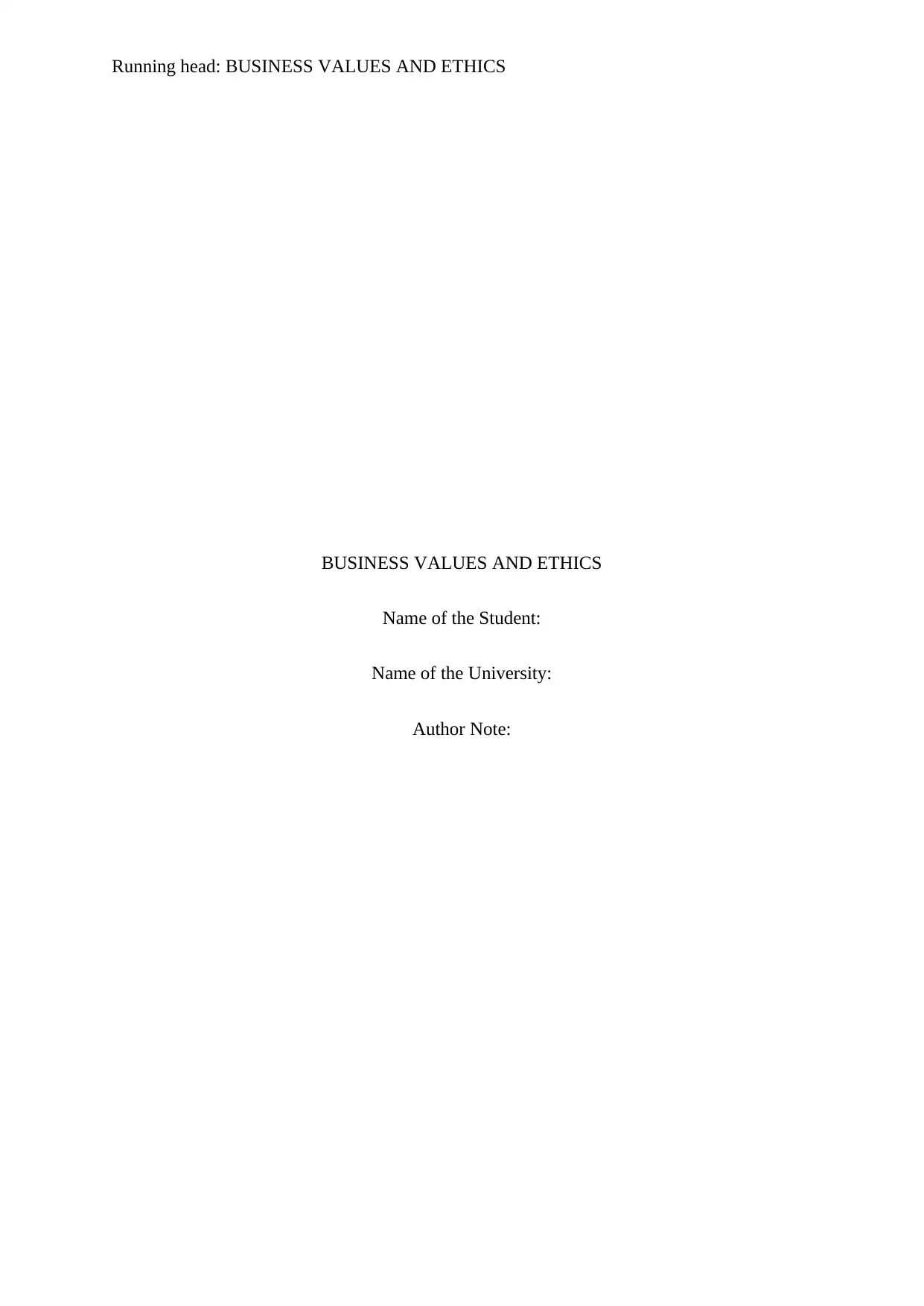
Running head: BUSINESS VALUES AND ETHICS
BUSINESS VALUES AND ETHICS
Name of the Student:
Name of the University:
Author Note:
BUSINESS VALUES AND ETHICS
Name of the Student:
Name of the University:
Author Note:
Secure Best Marks with AI Grader
Need help grading? Try our AI Grader for instant feedback on your assignments.
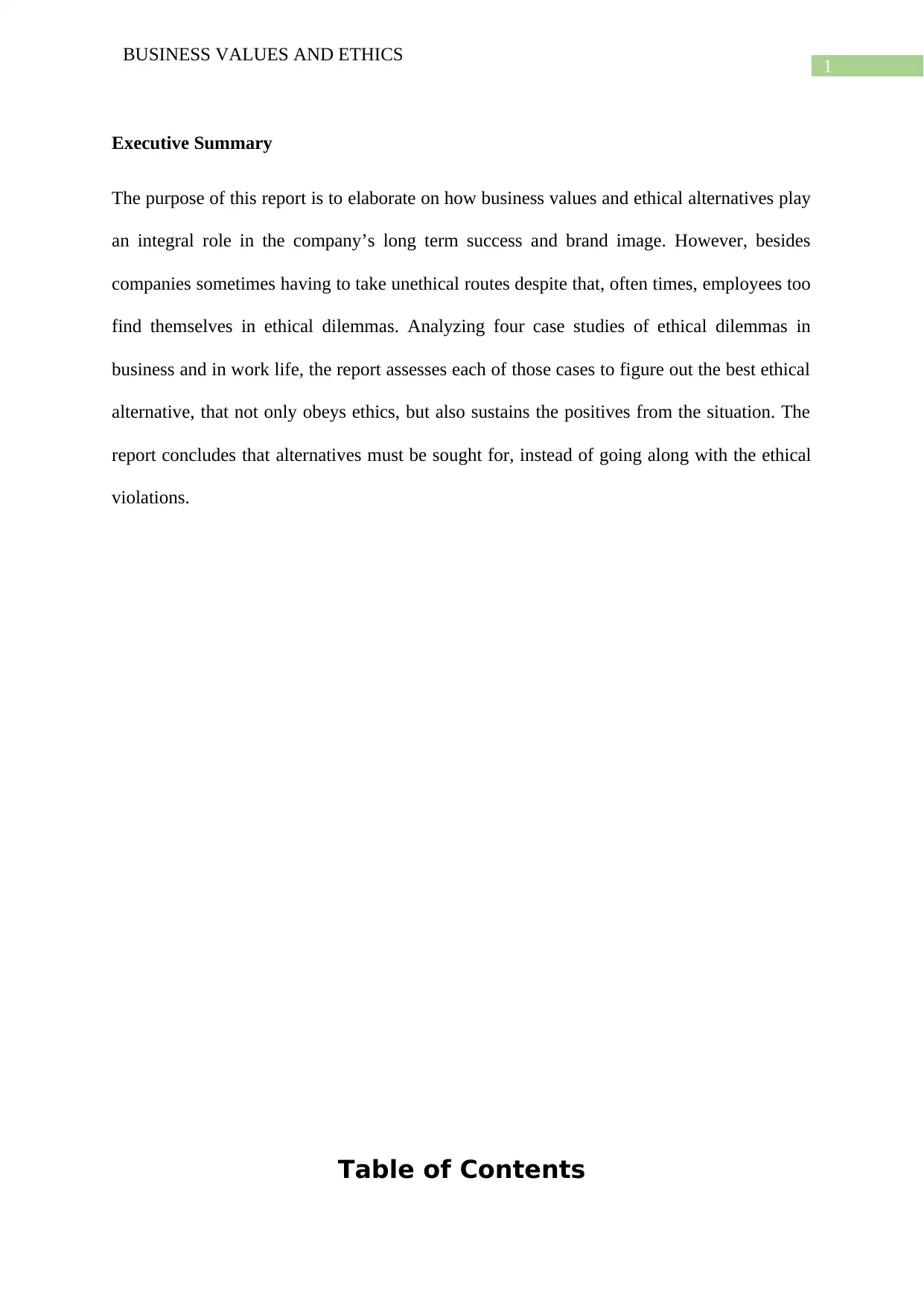
1
BUSINESS VALUES AND ETHICS
Executive Summary
The purpose of this report is to elaborate on how business values and ethical alternatives play
an integral role in the company’s long term success and brand image. However, besides
companies sometimes having to take unethical routes despite that, often times, employees too
find themselves in ethical dilemmas. Analyzing four case studies of ethical dilemmas in
business and in work life, the report assesses each of those cases to figure out the best ethical
alternative, that not only obeys ethics, but also sustains the positives from the situation. The
report concludes that alternatives must be sought for, instead of going along with the ethical
violations.
Table of Contents
BUSINESS VALUES AND ETHICS
Executive Summary
The purpose of this report is to elaborate on how business values and ethical alternatives play
an integral role in the company’s long term success and brand image. However, besides
companies sometimes having to take unethical routes despite that, often times, employees too
find themselves in ethical dilemmas. Analyzing four case studies of ethical dilemmas in
business and in work life, the report assesses each of those cases to figure out the best ethical
alternative, that not only obeys ethics, but also sustains the positives from the situation. The
report concludes that alternatives must be sought for, instead of going along with the ethical
violations.
Table of Contents
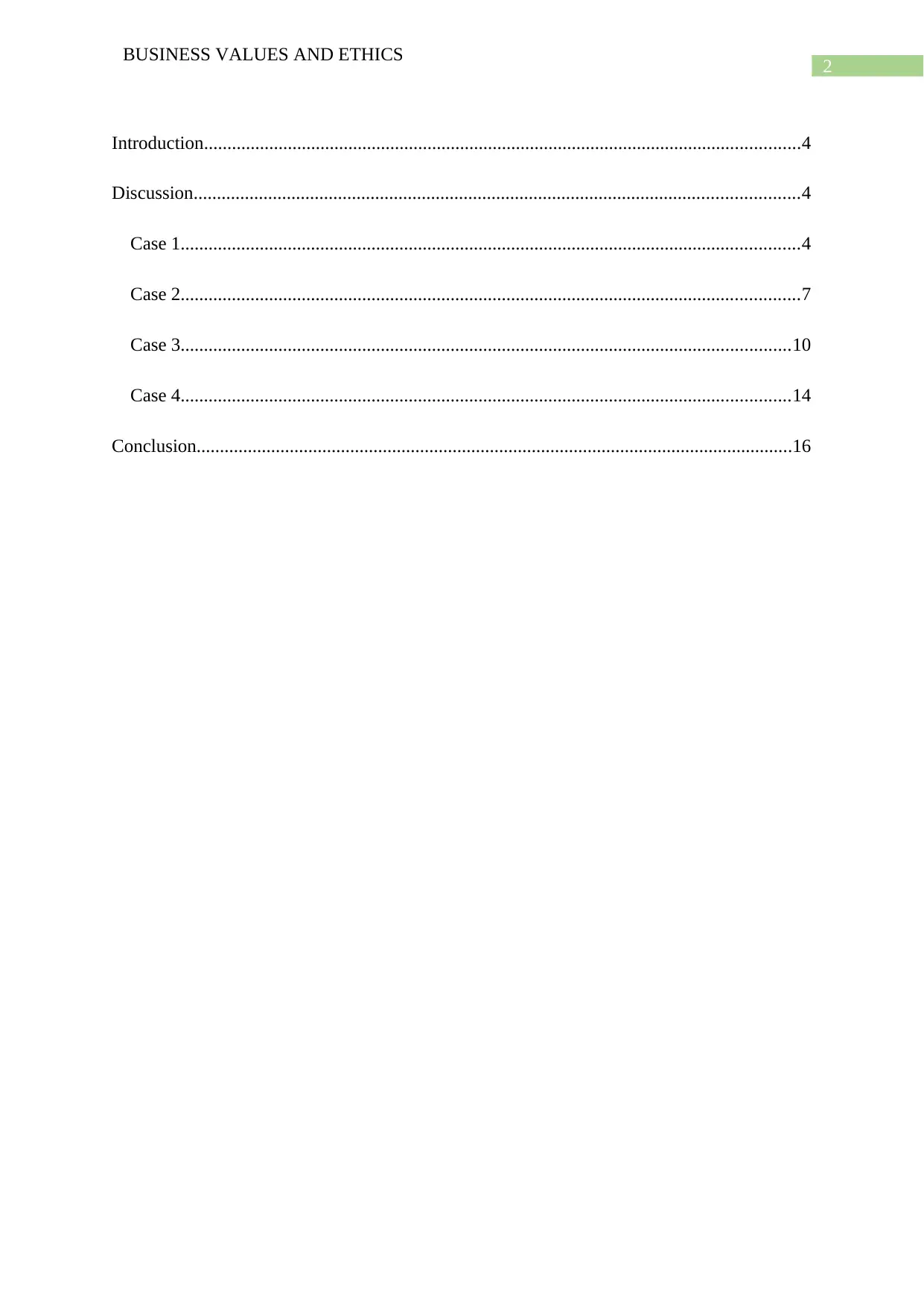
2
BUSINESS VALUES AND ETHICS
Introduction................................................................................................................................4
Discussion..................................................................................................................................4
Case 1.....................................................................................................................................4
Case 2.....................................................................................................................................7
Case 3...................................................................................................................................10
Case 4...................................................................................................................................14
Conclusion................................................................................................................................16
BUSINESS VALUES AND ETHICS
Introduction................................................................................................................................4
Discussion..................................................................................................................................4
Case 1.....................................................................................................................................4
Case 2.....................................................................................................................................7
Case 3...................................................................................................................................10
Case 4...................................................................................................................................14
Conclusion................................................................................................................................16
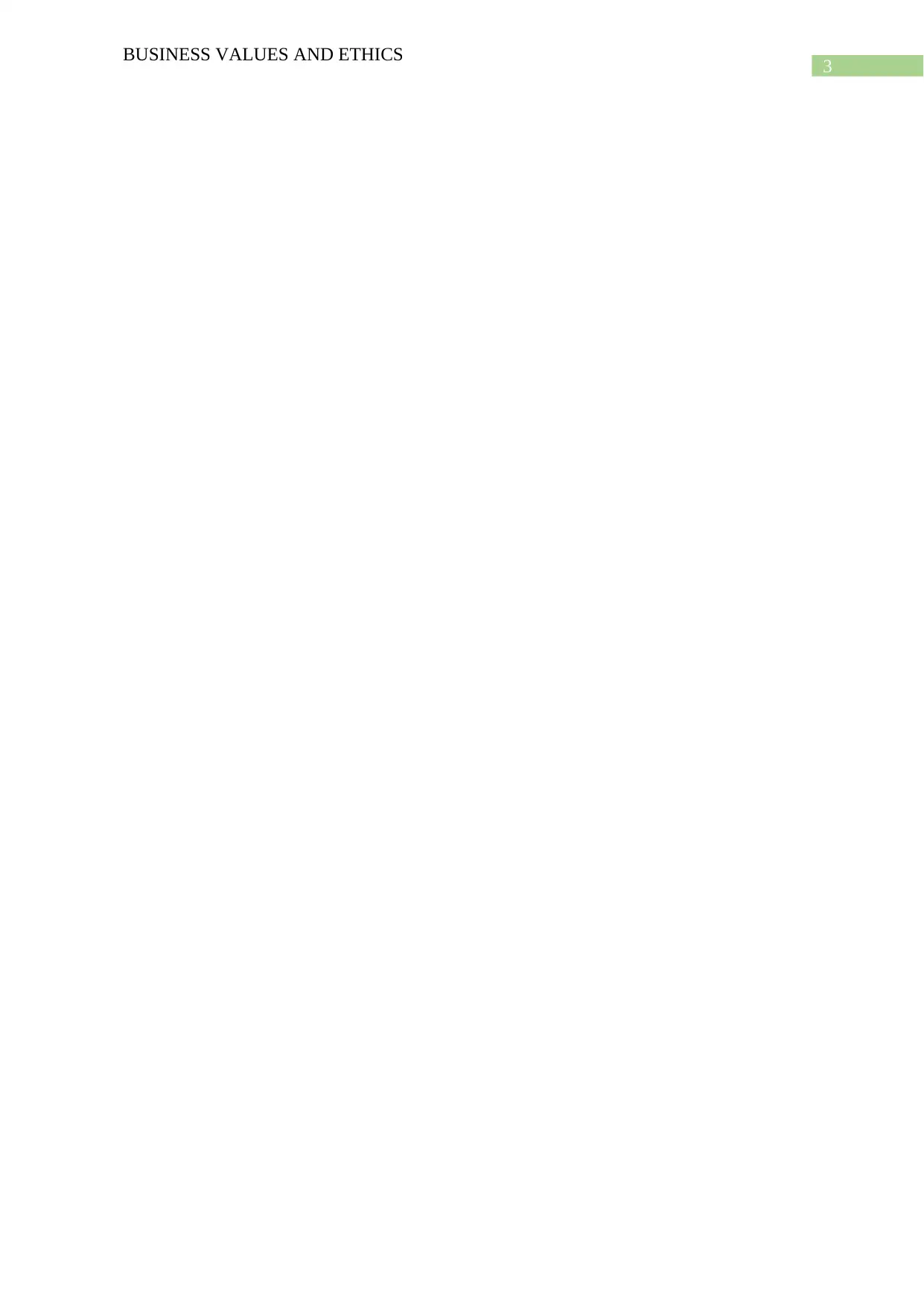
3
BUSINESS VALUES AND ETHICS
BUSINESS VALUES AND ETHICS
Secure Best Marks with AI Grader
Need help grading? Try our AI Grader for instant feedback on your assignments.

4
BUSINESS VALUES AND ETHICS
Introduction
Ethics in business play an important role in determining the consequences and
morality of the business. Often times, companies and employees find themselves in dilemmas
of what is right and what is wrong. Sometimes, choosing to do what is right, might not be
fruitful for the company or for the employee’s career (Strobel, Tumasjan and Welpe 2015).
Hence, the entity has to look for alternatives which might not be ethical, just to serve the
purpose of his her career, or of the company as a whole (Fleischman et al. 2017). The aim of
this report is to recommend alternatives to businesses and employees through which they can
not only protect the company and their careers, but also maintain ethics in the actions that
they take, protecting the rights of the stakeholders as much as possible.
To serve the aim of this report, four distinct case studies will be taken up and
analysed, and possible alternatives will be attempted to be provided for each case. Every case
study has its own ethical dilemma, and factors such as ethical issues, practical constraints,
primary stakeholders and ethics of possible alternatives will be considered in the discussion
for each case, to analyse and recommend the ethical alternatives for the case.
Discussion
Case 1
1. The relevant facts in this case are as follows-
Rachel is a quality assurance engineer at an electronics company, responsible for
testing and shipping of finished products to the distributors.
The company has a contract with another company which manufactures the chips that
Rachel’s company incorporates into the servers that they ship.
Rachel has limited time for quality assurance since the policy is to release a new
generation of servers in the market every six months.
BUSINESS VALUES AND ETHICS
Introduction
Ethics in business play an important role in determining the consequences and
morality of the business. Often times, companies and employees find themselves in dilemmas
of what is right and what is wrong. Sometimes, choosing to do what is right, might not be
fruitful for the company or for the employee’s career (Strobel, Tumasjan and Welpe 2015).
Hence, the entity has to look for alternatives which might not be ethical, just to serve the
purpose of his her career, or of the company as a whole (Fleischman et al. 2017). The aim of
this report is to recommend alternatives to businesses and employees through which they can
not only protect the company and their careers, but also maintain ethics in the actions that
they take, protecting the rights of the stakeholders as much as possible.
To serve the aim of this report, four distinct case studies will be taken up and
analysed, and possible alternatives will be attempted to be provided for each case. Every case
study has its own ethical dilemma, and factors such as ethical issues, practical constraints,
primary stakeholders and ethics of possible alternatives will be considered in the discussion
for each case, to analyse and recommend the ethical alternatives for the case.
Discussion
Case 1
1. The relevant facts in this case are as follows-
Rachel is a quality assurance engineer at an electronics company, responsible for
testing and shipping of finished products to the distributors.
The company has a contract with another company which manufactures the chips that
Rachel’s company incorporates into the servers that they ship.
Rachel has limited time for quality assurance since the policy is to release a new
generation of servers in the market every six months.
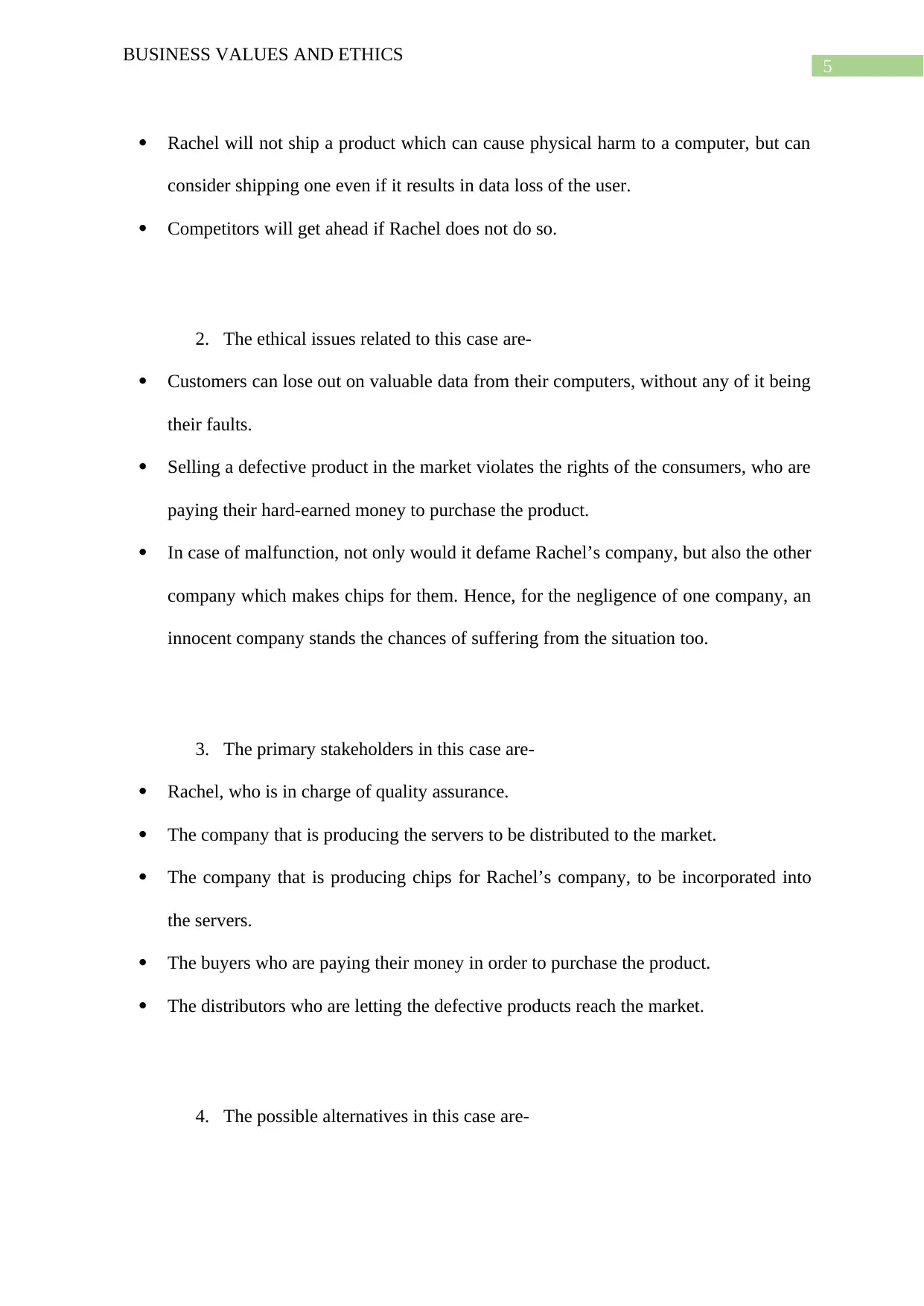
5
BUSINESS VALUES AND ETHICS
Rachel will not ship a product which can cause physical harm to a computer, but can
consider shipping one even if it results in data loss of the user.
Competitors will get ahead if Rachel does not do so.
2. The ethical issues related to this case are-
Customers can lose out on valuable data from their computers, without any of it being
their faults.
Selling a defective product in the market violates the rights of the consumers, who are
paying their hard-earned money to purchase the product.
In case of malfunction, not only would it defame Rachel’s company, but also the other
company which makes chips for them. Hence, for the negligence of one company, an
innocent company stands the chances of suffering from the situation too.
3. The primary stakeholders in this case are-
Rachel, who is in charge of quality assurance.
The company that is producing the servers to be distributed to the market.
The company that is producing chips for Rachel’s company, to be incorporated into
the servers.
The buyers who are paying their money in order to purchase the product.
The distributors who are letting the defective products reach the market.
4. The possible alternatives in this case are-
BUSINESS VALUES AND ETHICS
Rachel will not ship a product which can cause physical harm to a computer, but can
consider shipping one even if it results in data loss of the user.
Competitors will get ahead if Rachel does not do so.
2. The ethical issues related to this case are-
Customers can lose out on valuable data from their computers, without any of it being
their faults.
Selling a defective product in the market violates the rights of the consumers, who are
paying their hard-earned money to purchase the product.
In case of malfunction, not only would it defame Rachel’s company, but also the other
company which makes chips for them. Hence, for the negligence of one company, an
innocent company stands the chances of suffering from the situation too.
3. The primary stakeholders in this case are-
Rachel, who is in charge of quality assurance.
The company that is producing the servers to be distributed to the market.
The company that is producing chips for Rachel’s company, to be incorporated into
the servers.
The buyers who are paying their money in order to purchase the product.
The distributors who are letting the defective products reach the market.
4. The possible alternatives in this case are-
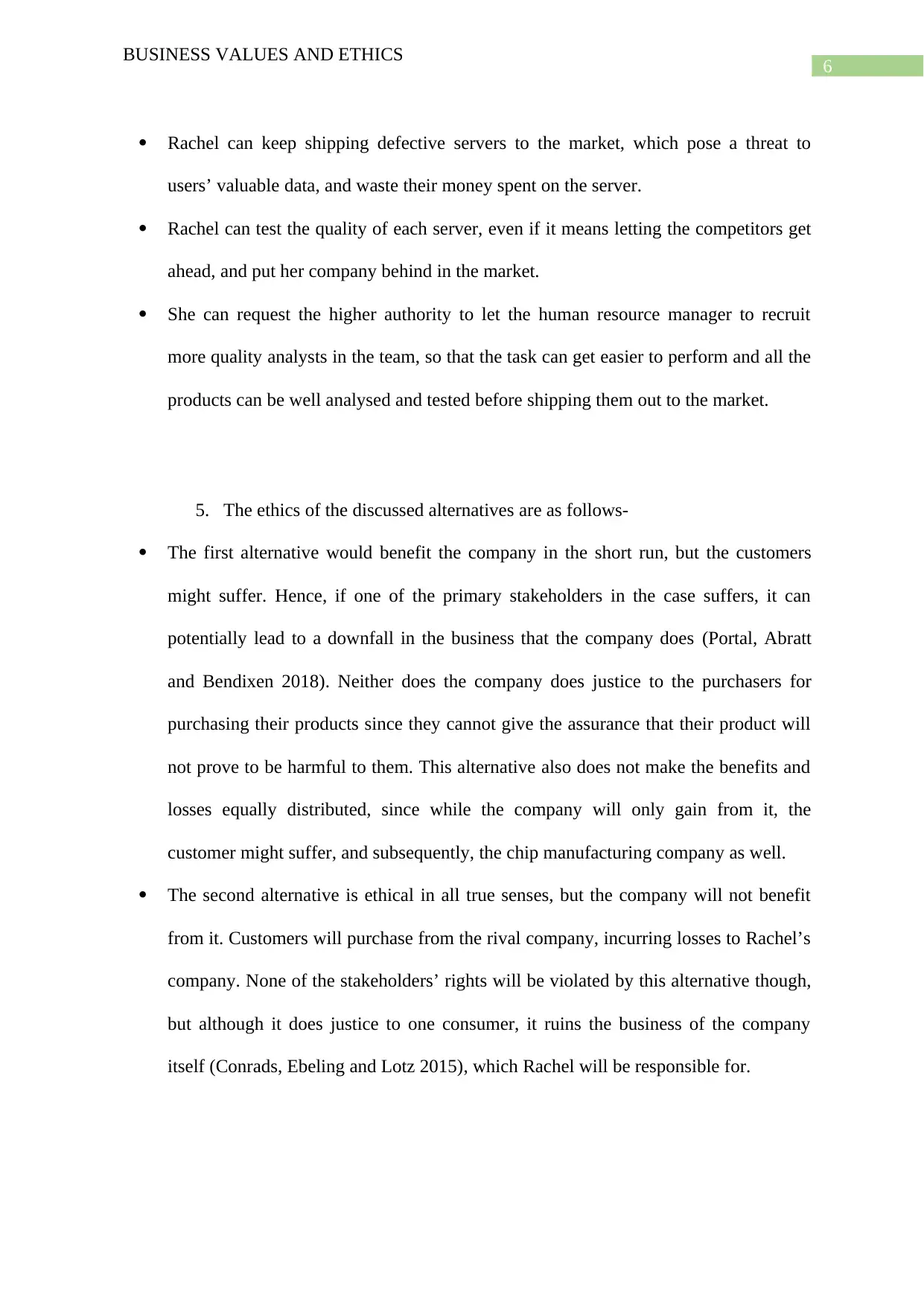
6
BUSINESS VALUES AND ETHICS
Rachel can keep shipping defective servers to the market, which pose a threat to
users’ valuable data, and waste their money spent on the server.
Rachel can test the quality of each server, even if it means letting the competitors get
ahead, and put her company behind in the market.
She can request the higher authority to let the human resource manager to recruit
more quality analysts in the team, so that the task can get easier to perform and all the
products can be well analysed and tested before shipping them out to the market.
5. The ethics of the discussed alternatives are as follows-
The first alternative would benefit the company in the short run, but the customers
might suffer. Hence, if one of the primary stakeholders in the case suffers, it can
potentially lead to a downfall in the business that the company does (Portal, Abratt
and Bendixen 2018). Neither does the company does justice to the purchasers for
purchasing their products since they cannot give the assurance that their product will
not prove to be harmful to them. This alternative also does not make the benefits and
losses equally distributed, since while the company will only gain from it, the
customer might suffer, and subsequently, the chip manufacturing company as well.
The second alternative is ethical in all true senses, but the company will not benefit
from it. Customers will purchase from the rival company, incurring losses to Rachel’s
company. None of the stakeholders’ rights will be violated by this alternative though,
but although it does justice to one consumer, it ruins the business of the company
itself (Conrads, Ebeling and Lotz 2015), which Rachel will be responsible for.
BUSINESS VALUES AND ETHICS
Rachel can keep shipping defective servers to the market, which pose a threat to
users’ valuable data, and waste their money spent on the server.
Rachel can test the quality of each server, even if it means letting the competitors get
ahead, and put her company behind in the market.
She can request the higher authority to let the human resource manager to recruit
more quality analysts in the team, so that the task can get easier to perform and all the
products can be well analysed and tested before shipping them out to the market.
5. The ethics of the discussed alternatives are as follows-
The first alternative would benefit the company in the short run, but the customers
might suffer. Hence, if one of the primary stakeholders in the case suffers, it can
potentially lead to a downfall in the business that the company does (Portal, Abratt
and Bendixen 2018). Neither does the company does justice to the purchasers for
purchasing their products since they cannot give the assurance that their product will
not prove to be harmful to them. This alternative also does not make the benefits and
losses equally distributed, since while the company will only gain from it, the
customer might suffer, and subsequently, the chip manufacturing company as well.
The second alternative is ethical in all true senses, but the company will not benefit
from it. Customers will purchase from the rival company, incurring losses to Rachel’s
company. None of the stakeholders’ rights will be violated by this alternative though,
but although it does justice to one consumer, it ruins the business of the company
itself (Conrads, Ebeling and Lotz 2015), which Rachel will be responsible for.
Paraphrase This Document
Need a fresh take? Get an instant paraphrase of this document with our AI Paraphraser

7
BUSINESS VALUES AND ETHICS
The third alternative makes sure that no party is harmed. Justice is served to all the
stakeholders, and the benefits and burdens are distributed equally in this case (Scott.
2016).
Rights and duties-
It is the company’s right to make profits, and its duty to ensure that it does not betray or
harm the interests of other parties involved in its business, and provide quality products for
the price that it charges
6. The practical constraints in the scenario are-
The brand value and image of the company could fall terribly if a mass number of
servers begin affecting the computers of the purchasers. Rachel will obviously be held
accountable for her negligence. The brand image of the chip manufacturing company
would also fall when people come to realise that they are the ones in partnership with
the company (Wilson 2017).
The action that is the safest to take for Rachel in this scenario would be to go for the third
alternative, and ask the higher authority to provide support with more employees in the team
since so much of work is getting impossible to be done by the current number of team
members at the moment, and may result in casualties. If denied from the higher authority,
Rachel should first distribute the products which are known to be free of defects. If that does
not suffice the competition, she should distribute the defective ones as a last resort. Perhaps,
the best solution for the company as a whole would be to have a warranty period ensured to
its consumers, so that competition and ethics both can be served with justice (Alqahtani and
Gupta 2017). But that of course, is not in Rachel’s hands to implement.
BUSINESS VALUES AND ETHICS
The third alternative makes sure that no party is harmed. Justice is served to all the
stakeholders, and the benefits and burdens are distributed equally in this case (Scott.
2016).
Rights and duties-
It is the company’s right to make profits, and its duty to ensure that it does not betray or
harm the interests of other parties involved in its business, and provide quality products for
the price that it charges
6. The practical constraints in the scenario are-
The brand value and image of the company could fall terribly if a mass number of
servers begin affecting the computers of the purchasers. Rachel will obviously be held
accountable for her negligence. The brand image of the chip manufacturing company
would also fall when people come to realise that they are the ones in partnership with
the company (Wilson 2017).
The action that is the safest to take for Rachel in this scenario would be to go for the third
alternative, and ask the higher authority to provide support with more employees in the team
since so much of work is getting impossible to be done by the current number of team
members at the moment, and may result in casualties. If denied from the higher authority,
Rachel should first distribute the products which are known to be free of defects. If that does
not suffice the competition, she should distribute the defective ones as a last resort. Perhaps,
the best solution for the company as a whole would be to have a warranty period ensured to
its consumers, so that competition and ethics both can be served with justice (Alqahtani and
Gupta 2017). But that of course, is not in Rachel’s hands to implement.
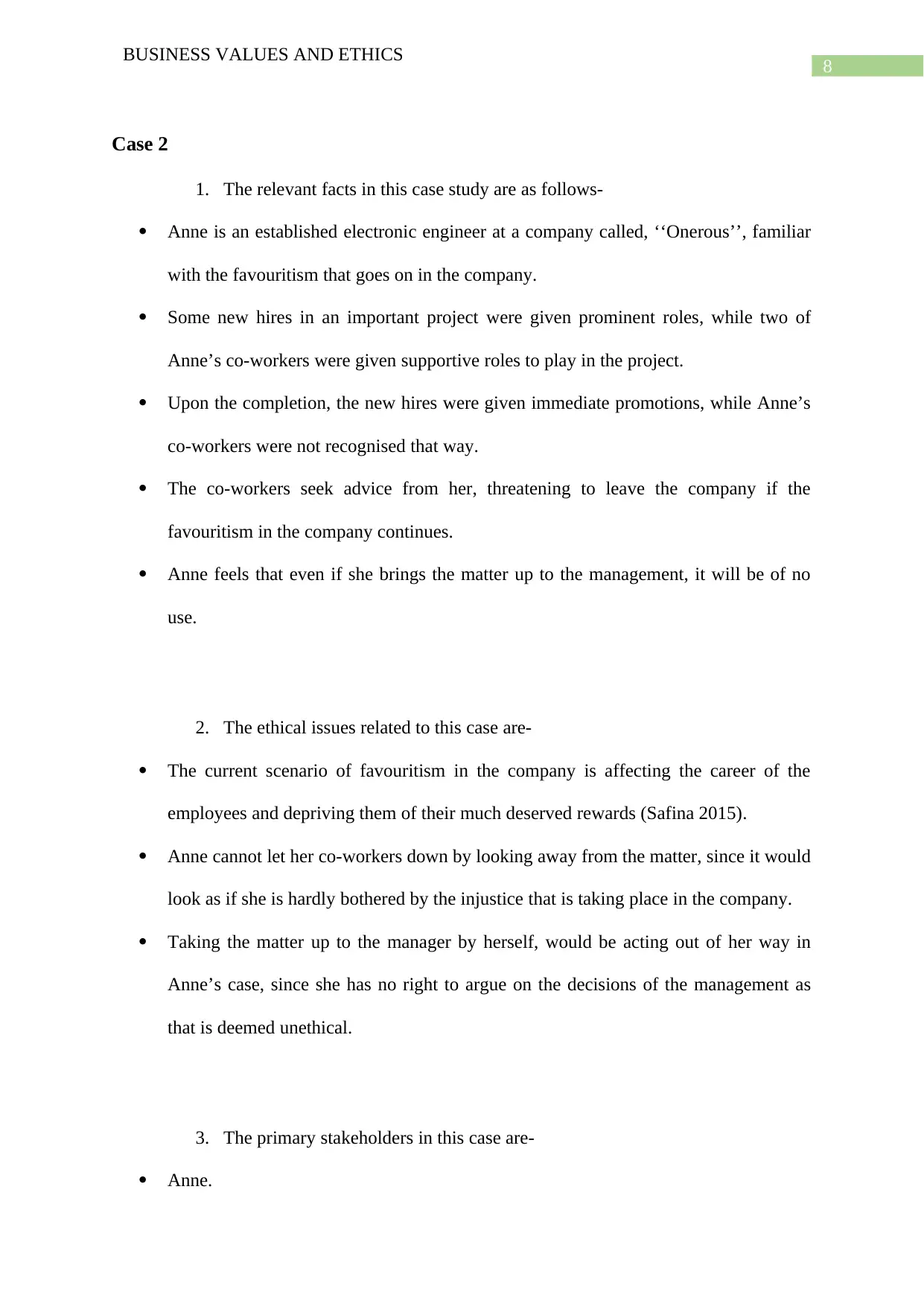
8
BUSINESS VALUES AND ETHICS
Case 2
1. The relevant facts in this case study are as follows-
Anne is an established electronic engineer at a company called, ‘‘Onerous’’, familiar
with the favouritism that goes on in the company.
Some new hires in an important project were given prominent roles, while two of
Anne’s co-workers were given supportive roles to play in the project.
Upon the completion, the new hires were given immediate promotions, while Anne’s
co-workers were not recognised that way.
The co-workers seek advice from her, threatening to leave the company if the
favouritism in the company continues.
Anne feels that even if she brings the matter up to the management, it will be of no
use.
2. The ethical issues related to this case are-
The current scenario of favouritism in the company is affecting the career of the
employees and depriving them of their much deserved rewards (Safina 2015).
Anne cannot let her co-workers down by looking away from the matter, since it would
look as if she is hardly bothered by the injustice that is taking place in the company.
Taking the matter up to the manager by herself, would be acting out of her way in
Anne’s case, since she has no right to argue on the decisions of the management as
that is deemed unethical.
3. The primary stakeholders in this case are-
Anne.
BUSINESS VALUES AND ETHICS
Case 2
1. The relevant facts in this case study are as follows-
Anne is an established electronic engineer at a company called, ‘‘Onerous’’, familiar
with the favouritism that goes on in the company.
Some new hires in an important project were given prominent roles, while two of
Anne’s co-workers were given supportive roles to play in the project.
Upon the completion, the new hires were given immediate promotions, while Anne’s
co-workers were not recognised that way.
The co-workers seek advice from her, threatening to leave the company if the
favouritism in the company continues.
Anne feels that even if she brings the matter up to the management, it will be of no
use.
2. The ethical issues related to this case are-
The current scenario of favouritism in the company is affecting the career of the
employees and depriving them of their much deserved rewards (Safina 2015).
Anne cannot let her co-workers down by looking away from the matter, since it would
look as if she is hardly bothered by the injustice that is taking place in the company.
Taking the matter up to the manager by herself, would be acting out of her way in
Anne’s case, since she has no right to argue on the decisions of the management as
that is deemed unethical.
3. The primary stakeholders in this case are-
Anne.
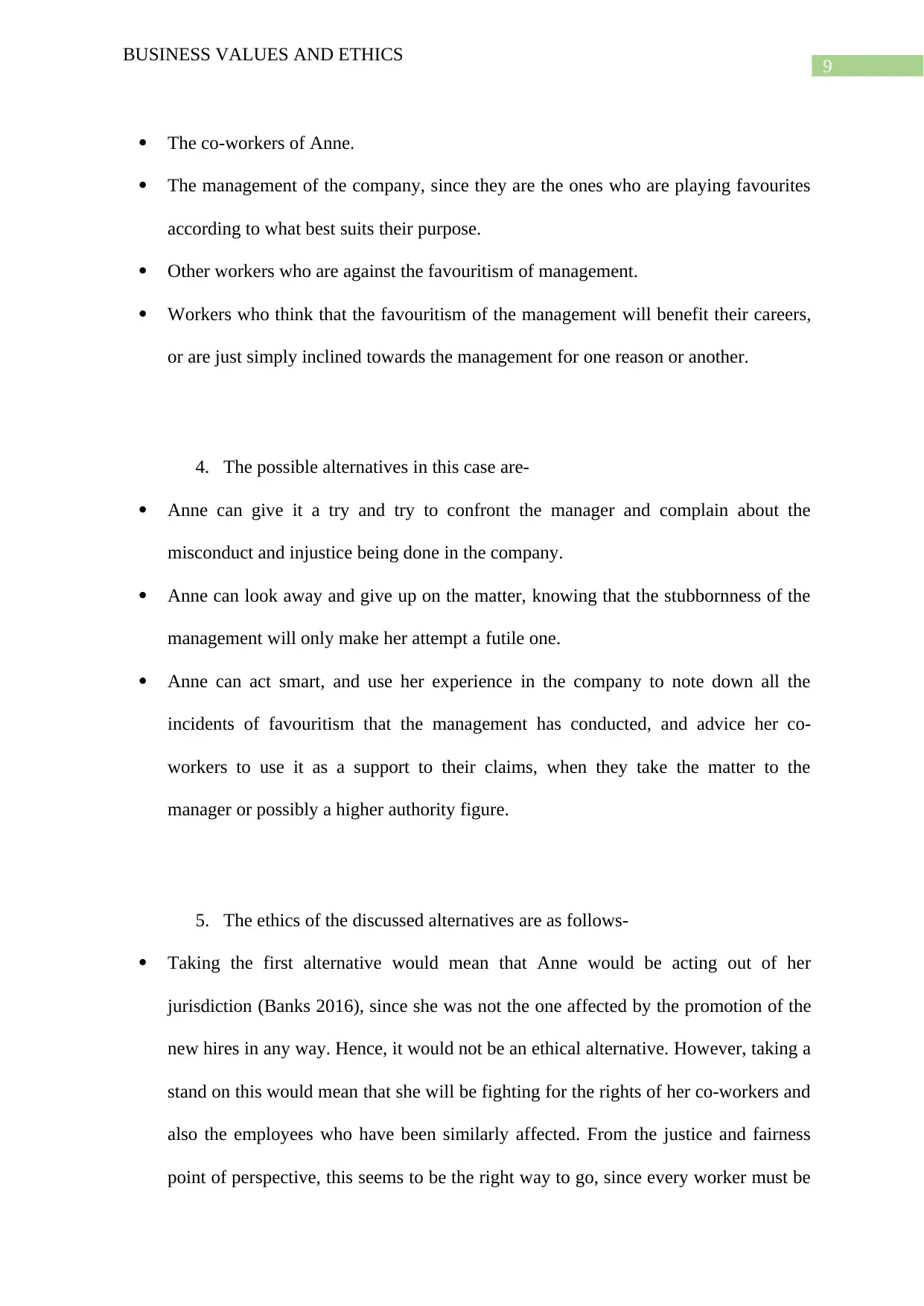
9
BUSINESS VALUES AND ETHICS
The co-workers of Anne.
The management of the company, since they are the ones who are playing favourites
according to what best suits their purpose.
Other workers who are against the favouritism of management.
Workers who think that the favouritism of the management will benefit their careers,
or are just simply inclined towards the management for one reason or another.
4. The possible alternatives in this case are-
Anne can give it a try and try to confront the manager and complain about the
misconduct and injustice being done in the company.
Anne can look away and give up on the matter, knowing that the stubbornness of the
management will only make her attempt a futile one.
Anne can act smart, and use her experience in the company to note down all the
incidents of favouritism that the management has conducted, and advice her co-
workers to use it as a support to their claims, when they take the matter to the
manager or possibly a higher authority figure.
5. The ethics of the discussed alternatives are as follows-
Taking the first alternative would mean that Anne would be acting out of her
jurisdiction (Banks 2016), since she was not the one affected by the promotion of the
new hires in any way. Hence, it would not be an ethical alternative. However, taking a
stand on this would mean that she will be fighting for the rights of her co-workers and
also the employees who have been similarly affected. From the justice and fairness
point of perspective, this seems to be the right way to go, since every worker must be
BUSINESS VALUES AND ETHICS
The co-workers of Anne.
The management of the company, since they are the ones who are playing favourites
according to what best suits their purpose.
Other workers who are against the favouritism of management.
Workers who think that the favouritism of the management will benefit their careers,
or are just simply inclined towards the management for one reason or another.
4. The possible alternatives in this case are-
Anne can give it a try and try to confront the manager and complain about the
misconduct and injustice being done in the company.
Anne can look away and give up on the matter, knowing that the stubbornness of the
management will only make her attempt a futile one.
Anne can act smart, and use her experience in the company to note down all the
incidents of favouritism that the management has conducted, and advice her co-
workers to use it as a support to their claims, when they take the matter to the
manager or possibly a higher authority figure.
5. The ethics of the discussed alternatives are as follows-
Taking the first alternative would mean that Anne would be acting out of her
jurisdiction (Banks 2016), since she was not the one affected by the promotion of the
new hires in any way. Hence, it would not be an ethical alternative. However, taking a
stand on this would mean that she will be fighting for the rights of her co-workers and
also the employees who have been similarly affected. From the justice and fairness
point of perspective, this seems to be the right way to go, since every worker must be
Secure Best Marks with AI Grader
Need help grading? Try our AI Grader for instant feedback on your assignments.
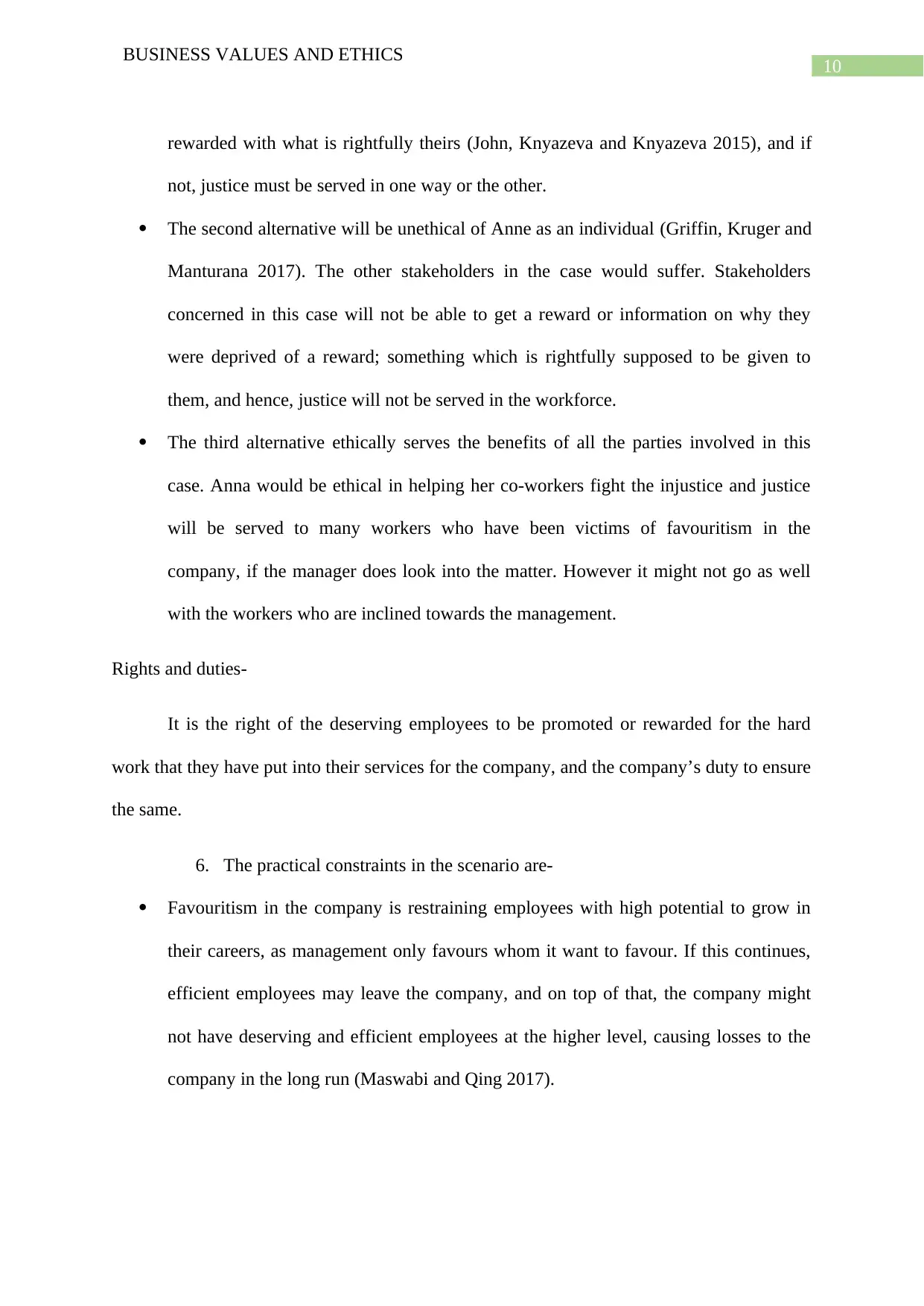
10
BUSINESS VALUES AND ETHICS
rewarded with what is rightfully theirs (John, Knyazeva and Knyazeva 2015), and if
not, justice must be served in one way or the other.
The second alternative will be unethical of Anne as an individual (Griffin, Kruger and
Manturana 2017). The other stakeholders in the case would suffer. Stakeholders
concerned in this case will not be able to get a reward or information on why they
were deprived of a reward; something which is rightfully supposed to be given to
them, and hence, justice will not be served in the workforce.
The third alternative ethically serves the benefits of all the parties involved in this
case. Anna would be ethical in helping her co-workers fight the injustice and justice
will be served to many workers who have been victims of favouritism in the
company, if the manager does look into the matter. However it might not go as well
with the workers who are inclined towards the management.
Rights and duties-
It is the right of the deserving employees to be promoted or rewarded for the hard
work that they have put into their services for the company, and the company’s duty to ensure
the same.
6. The practical constraints in the scenario are-
Favouritism in the company is restraining employees with high potential to grow in
their careers, as management only favours whom it want to favour. If this continues,
efficient employees may leave the company, and on top of that, the company might
not have deserving and efficient employees at the higher level, causing losses to the
company in the long run (Maswabi and Qing 2017).
BUSINESS VALUES AND ETHICS
rewarded with what is rightfully theirs (John, Knyazeva and Knyazeva 2015), and if
not, justice must be served in one way or the other.
The second alternative will be unethical of Anne as an individual (Griffin, Kruger and
Manturana 2017). The other stakeholders in the case would suffer. Stakeholders
concerned in this case will not be able to get a reward or information on why they
were deprived of a reward; something which is rightfully supposed to be given to
them, and hence, justice will not be served in the workforce.
The third alternative ethically serves the benefits of all the parties involved in this
case. Anna would be ethical in helping her co-workers fight the injustice and justice
will be served to many workers who have been victims of favouritism in the
company, if the manager does look into the matter. However it might not go as well
with the workers who are inclined towards the management.
Rights and duties-
It is the right of the deserving employees to be promoted or rewarded for the hard
work that they have put into their services for the company, and the company’s duty to ensure
the same.
6. The practical constraints in the scenario are-
Favouritism in the company is restraining employees with high potential to grow in
their careers, as management only favours whom it want to favour. If this continues,
efficient employees may leave the company, and on top of that, the company might
not have deserving and efficient employees at the higher level, causing losses to the
company in the long run (Maswabi and Qing 2017).
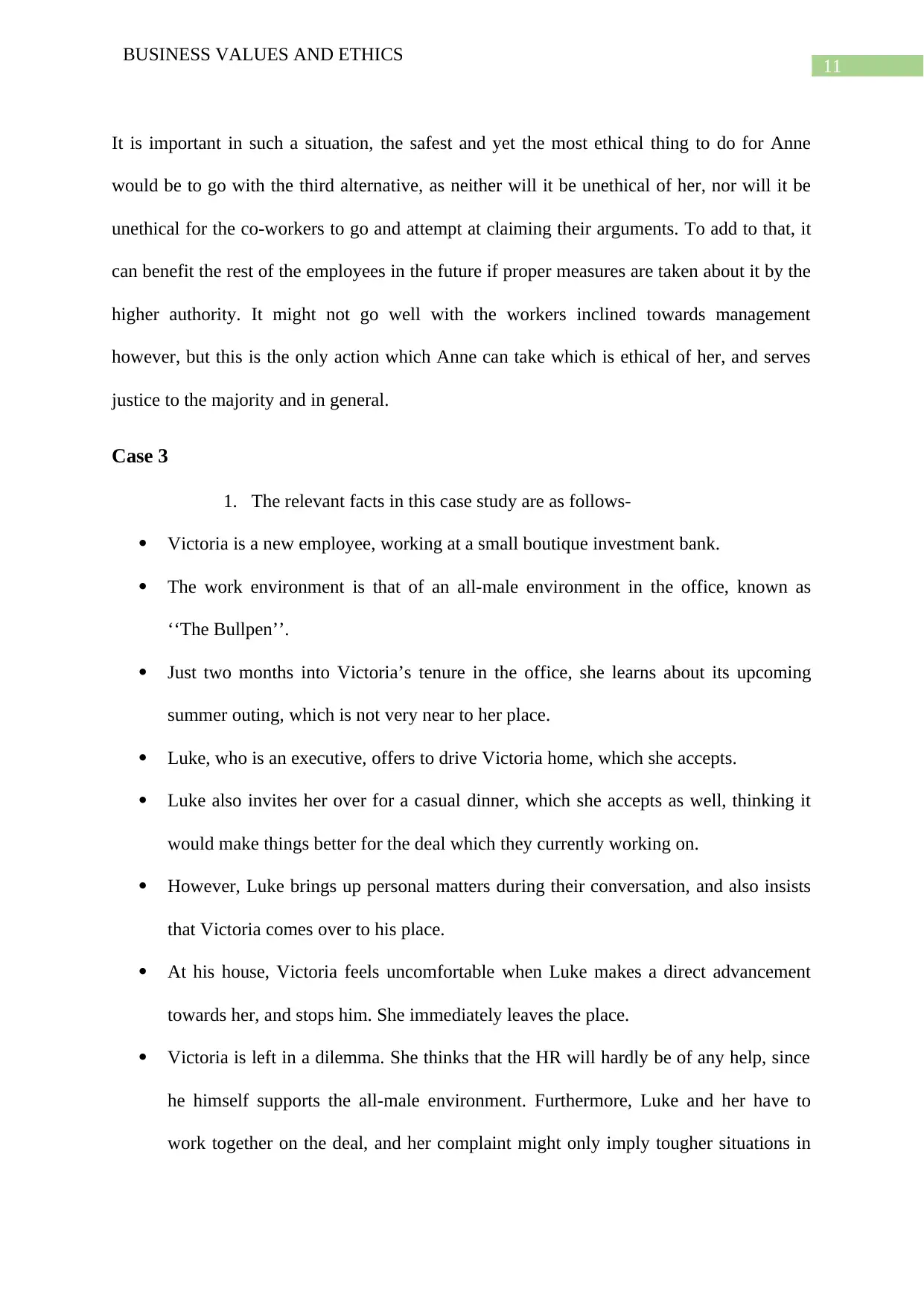
11
BUSINESS VALUES AND ETHICS
It is important in such a situation, the safest and yet the most ethical thing to do for Anne
would be to go with the third alternative, as neither will it be unethical of her, nor will it be
unethical for the co-workers to go and attempt at claiming their arguments. To add to that, it
can benefit the rest of the employees in the future if proper measures are taken about it by the
higher authority. It might not go well with the workers inclined towards management
however, but this is the only action which Anne can take which is ethical of her, and serves
justice to the majority and in general.
Case 3
1. The relevant facts in this case study are as follows-
Victoria is a new employee, working at a small boutique investment bank.
The work environment is that of an all-male environment in the office, known as
‘‘The Bullpen’’.
Just two months into Victoria’s tenure in the office, she learns about its upcoming
summer outing, which is not very near to her place.
Luke, who is an executive, offers to drive Victoria home, which she accepts.
Luke also invites her over for a casual dinner, which she accepts as well, thinking it
would make things better for the deal which they currently working on.
However, Luke brings up personal matters during their conversation, and also insists
that Victoria comes over to his place.
At his house, Victoria feels uncomfortable when Luke makes a direct advancement
towards her, and stops him. She immediately leaves the place.
Victoria is left in a dilemma. She thinks that the HR will hardly be of any help, since
he himself supports the all-male environment. Furthermore, Luke and her have to
work together on the deal, and her complaint might only imply tougher situations in
BUSINESS VALUES AND ETHICS
It is important in such a situation, the safest and yet the most ethical thing to do for Anne
would be to go with the third alternative, as neither will it be unethical of her, nor will it be
unethical for the co-workers to go and attempt at claiming their arguments. To add to that, it
can benefit the rest of the employees in the future if proper measures are taken about it by the
higher authority. It might not go well with the workers inclined towards management
however, but this is the only action which Anne can take which is ethical of her, and serves
justice to the majority and in general.
Case 3
1. The relevant facts in this case study are as follows-
Victoria is a new employee, working at a small boutique investment bank.
The work environment is that of an all-male environment in the office, known as
‘‘The Bullpen’’.
Just two months into Victoria’s tenure in the office, she learns about its upcoming
summer outing, which is not very near to her place.
Luke, who is an executive, offers to drive Victoria home, which she accepts.
Luke also invites her over for a casual dinner, which she accepts as well, thinking it
would make things better for the deal which they currently working on.
However, Luke brings up personal matters during their conversation, and also insists
that Victoria comes over to his place.
At his house, Victoria feels uncomfortable when Luke makes a direct advancement
towards her, and stops him. She immediately leaves the place.
Victoria is left in a dilemma. She thinks that the HR will hardly be of any help, since
he himself supports the all-male environment. Furthermore, Luke and her have to
work together on the deal, and her complaint might only imply tougher situations in
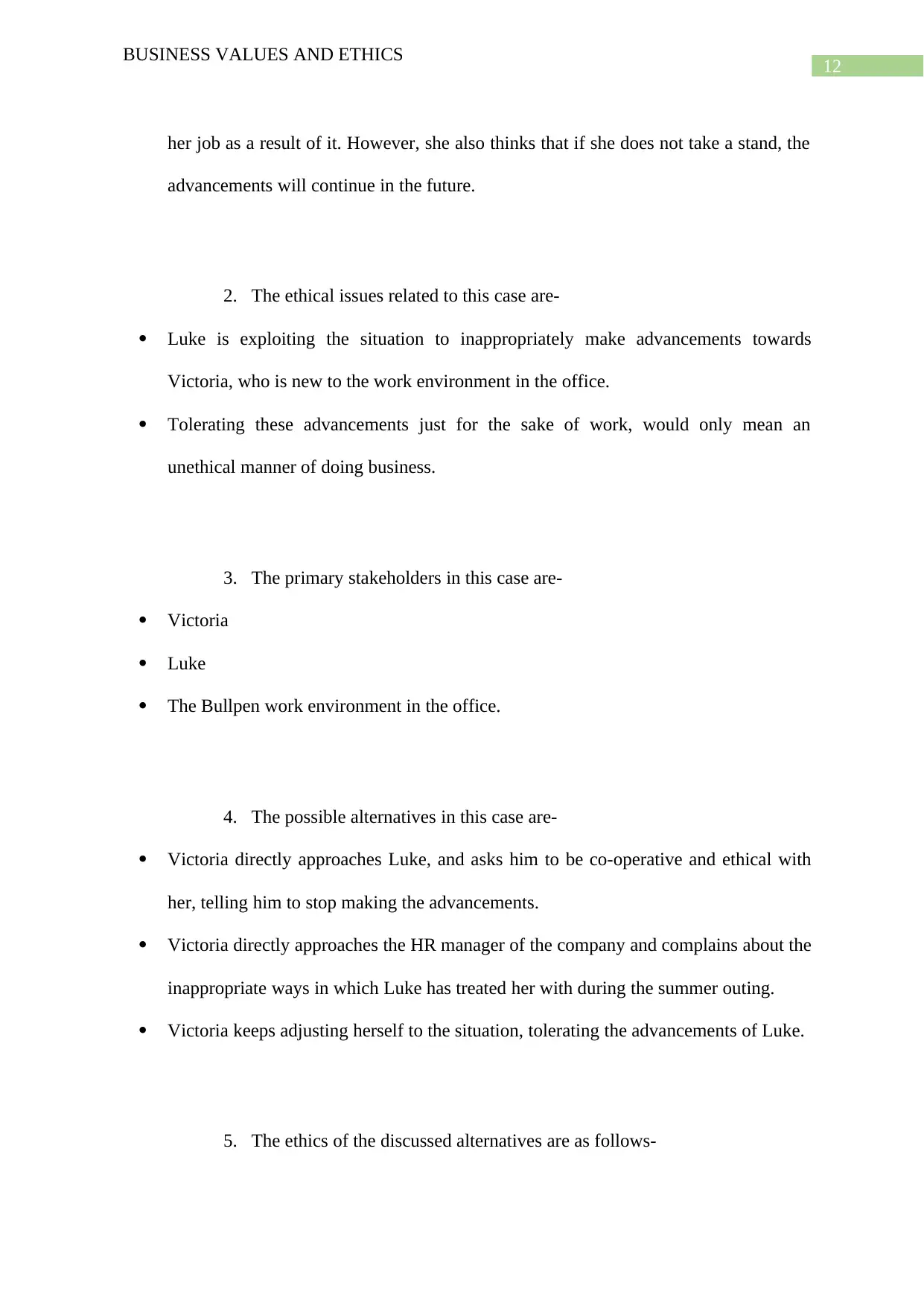
12
BUSINESS VALUES AND ETHICS
her job as a result of it. However, she also thinks that if she does not take a stand, the
advancements will continue in the future.
2. The ethical issues related to this case are-
Luke is exploiting the situation to inappropriately make advancements towards
Victoria, who is new to the work environment in the office.
Tolerating these advancements just for the sake of work, would only mean an
unethical manner of doing business.
3. The primary stakeholders in this case are-
Victoria
Luke
The Bullpen work environment in the office.
4. The possible alternatives in this case are-
Victoria directly approaches Luke, and asks him to be co-operative and ethical with
her, telling him to stop making the advancements.
Victoria directly approaches the HR manager of the company and complains about the
inappropriate ways in which Luke has treated her with during the summer outing.
Victoria keeps adjusting herself to the situation, tolerating the advancements of Luke.
5. The ethics of the discussed alternatives are as follows-
BUSINESS VALUES AND ETHICS
her job as a result of it. However, she also thinks that if she does not take a stand, the
advancements will continue in the future.
2. The ethical issues related to this case are-
Luke is exploiting the situation to inappropriately make advancements towards
Victoria, who is new to the work environment in the office.
Tolerating these advancements just for the sake of work, would only mean an
unethical manner of doing business.
3. The primary stakeholders in this case are-
Victoria
Luke
The Bullpen work environment in the office.
4. The possible alternatives in this case are-
Victoria directly approaches Luke, and asks him to be co-operative and ethical with
her, telling him to stop making the advancements.
Victoria directly approaches the HR manager of the company and complains about the
inappropriate ways in which Luke has treated her with during the summer outing.
Victoria keeps adjusting herself to the situation, tolerating the advancements of Luke.
5. The ethics of the discussed alternatives are as follows-
Paraphrase This Document
Need a fresh take? Get an instant paraphrase of this document with our AI Paraphraser
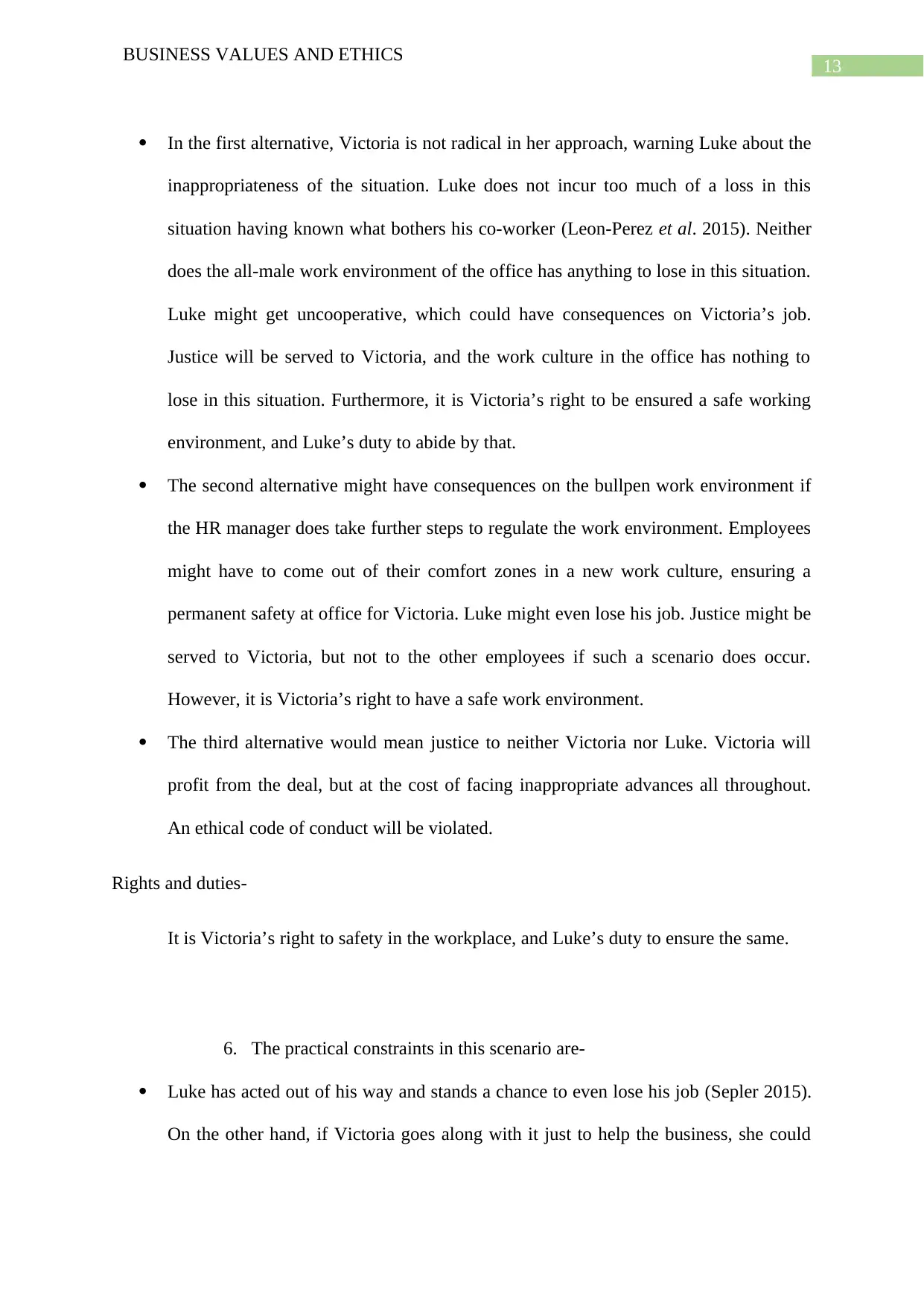
13
BUSINESS VALUES AND ETHICS
In the first alternative, Victoria is not radical in her approach, warning Luke about the
inappropriateness of the situation. Luke does not incur too much of a loss in this
situation having known what bothers his co-worker (Leon-Perez et al. 2015). Neither
does the all-male work environment of the office has anything to lose in this situation.
Luke might get uncooperative, which could have consequences on Victoria’s job.
Justice will be served to Victoria, and the work culture in the office has nothing to
lose in this situation. Furthermore, it is Victoria’s right to be ensured a safe working
environment, and Luke’s duty to abide by that.
The second alternative might have consequences on the bullpen work environment if
the HR manager does take further steps to regulate the work environment. Employees
might have to come out of their comfort zones in a new work culture, ensuring a
permanent safety at office for Victoria. Luke might even lose his job. Justice might be
served to Victoria, but not to the other employees if such a scenario does occur.
However, it is Victoria’s right to have a safe work environment.
The third alternative would mean justice to neither Victoria nor Luke. Victoria will
profit from the deal, but at the cost of facing inappropriate advances all throughout.
An ethical code of conduct will be violated.
Rights and duties-
It is Victoria’s right to safety in the workplace, and Luke’s duty to ensure the same.
6. The practical constraints in this scenario are-
Luke has acted out of his way and stands a chance to even lose his job (Sepler 2015).
On the other hand, if Victoria goes along with it just to help the business, she could
BUSINESS VALUES AND ETHICS
In the first alternative, Victoria is not radical in her approach, warning Luke about the
inappropriateness of the situation. Luke does not incur too much of a loss in this
situation having known what bothers his co-worker (Leon-Perez et al. 2015). Neither
does the all-male work environment of the office has anything to lose in this situation.
Luke might get uncooperative, which could have consequences on Victoria’s job.
Justice will be served to Victoria, and the work culture in the office has nothing to
lose in this situation. Furthermore, it is Victoria’s right to be ensured a safe working
environment, and Luke’s duty to abide by that.
The second alternative might have consequences on the bullpen work environment if
the HR manager does take further steps to regulate the work environment. Employees
might have to come out of their comfort zones in a new work culture, ensuring a
permanent safety at office for Victoria. Luke might even lose his job. Justice might be
served to Victoria, but not to the other employees if such a scenario does occur.
However, it is Victoria’s right to have a safe work environment.
The third alternative would mean justice to neither Victoria nor Luke. Victoria will
profit from the deal, but at the cost of facing inappropriate advances all throughout.
An ethical code of conduct will be violated.
Rights and duties-
It is Victoria’s right to safety in the workplace, and Luke’s duty to ensure the same.
6. The practical constraints in this scenario are-
Luke has acted out of his way and stands a chance to even lose his job (Sepler 2015).
On the other hand, if Victoria goes along with it just to help the business, she could
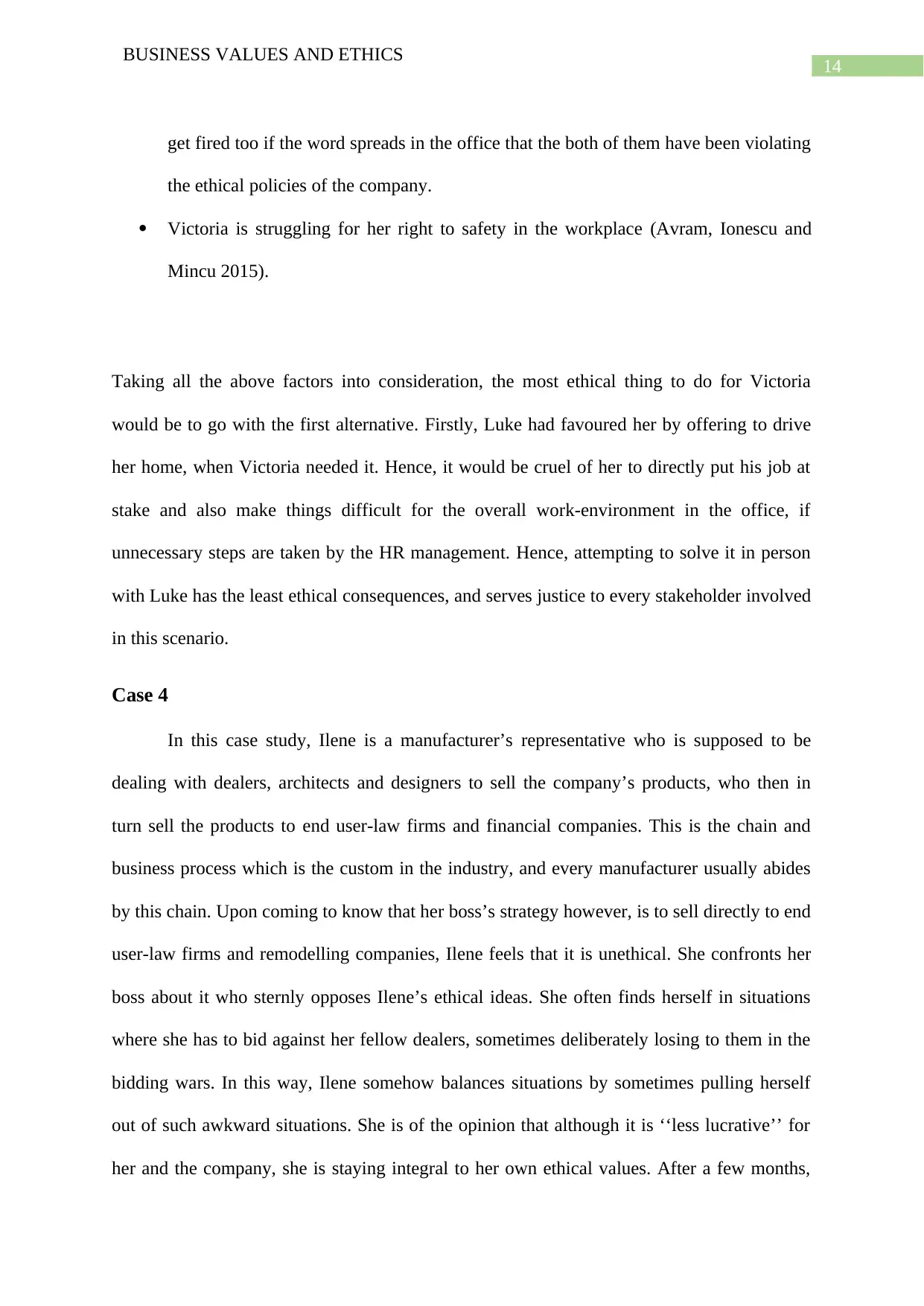
14
BUSINESS VALUES AND ETHICS
get fired too if the word spreads in the office that the both of them have been violating
the ethical policies of the company.
Victoria is struggling for her right to safety in the workplace (Avram, Ionescu and
Mincu 2015).
Taking all the above factors into consideration, the most ethical thing to do for Victoria
would be to go with the first alternative. Firstly, Luke had favoured her by offering to drive
her home, when Victoria needed it. Hence, it would be cruel of her to directly put his job at
stake and also make things difficult for the overall work-environment in the office, if
unnecessary steps are taken by the HR management. Hence, attempting to solve it in person
with Luke has the least ethical consequences, and serves justice to every stakeholder involved
in this scenario.
Case 4
In this case study, Ilene is a manufacturer’s representative who is supposed to be
dealing with dealers, architects and designers to sell the company’s products, who then in
turn sell the products to end user-law firms and financial companies. This is the chain and
business process which is the custom in the industry, and every manufacturer usually abides
by this chain. Upon coming to know that her boss’s strategy however, is to sell directly to end
user-law firms and remodelling companies, Ilene feels that it is unethical. She confronts her
boss about it who sternly opposes Ilene’s ethical ideas. She often finds herself in situations
where she has to bid against her fellow dealers, sometimes deliberately losing to them in the
bidding wars. In this way, Ilene somehow balances situations by sometimes pulling herself
out of such awkward situations. She is of the opinion that although it is ‘‘less lucrative’’ for
her and the company, she is staying integral to her own ethical values. After a few months,
BUSINESS VALUES AND ETHICS
get fired too if the word spreads in the office that the both of them have been violating
the ethical policies of the company.
Victoria is struggling for her right to safety in the workplace (Avram, Ionescu and
Mincu 2015).
Taking all the above factors into consideration, the most ethical thing to do for Victoria
would be to go with the first alternative. Firstly, Luke had favoured her by offering to drive
her home, when Victoria needed it. Hence, it would be cruel of her to directly put his job at
stake and also make things difficult for the overall work-environment in the office, if
unnecessary steps are taken by the HR management. Hence, attempting to solve it in person
with Luke has the least ethical consequences, and serves justice to every stakeholder involved
in this scenario.
Case 4
In this case study, Ilene is a manufacturer’s representative who is supposed to be
dealing with dealers, architects and designers to sell the company’s products, who then in
turn sell the products to end user-law firms and financial companies. This is the chain and
business process which is the custom in the industry, and every manufacturer usually abides
by this chain. Upon coming to know that her boss’s strategy however, is to sell directly to end
user-law firms and remodelling companies, Ilene feels that it is unethical. She confronts her
boss about it who sternly opposes Ilene’s ethical ideas. She often finds herself in situations
where she has to bid against her fellow dealers, sometimes deliberately losing to them in the
bidding wars. In this way, Ilene somehow balances situations by sometimes pulling herself
out of such awkward situations. She is of the opinion that although it is ‘‘less lucrative’’ for
her and the company, she is staying integral to her own ethical values. After a few months,
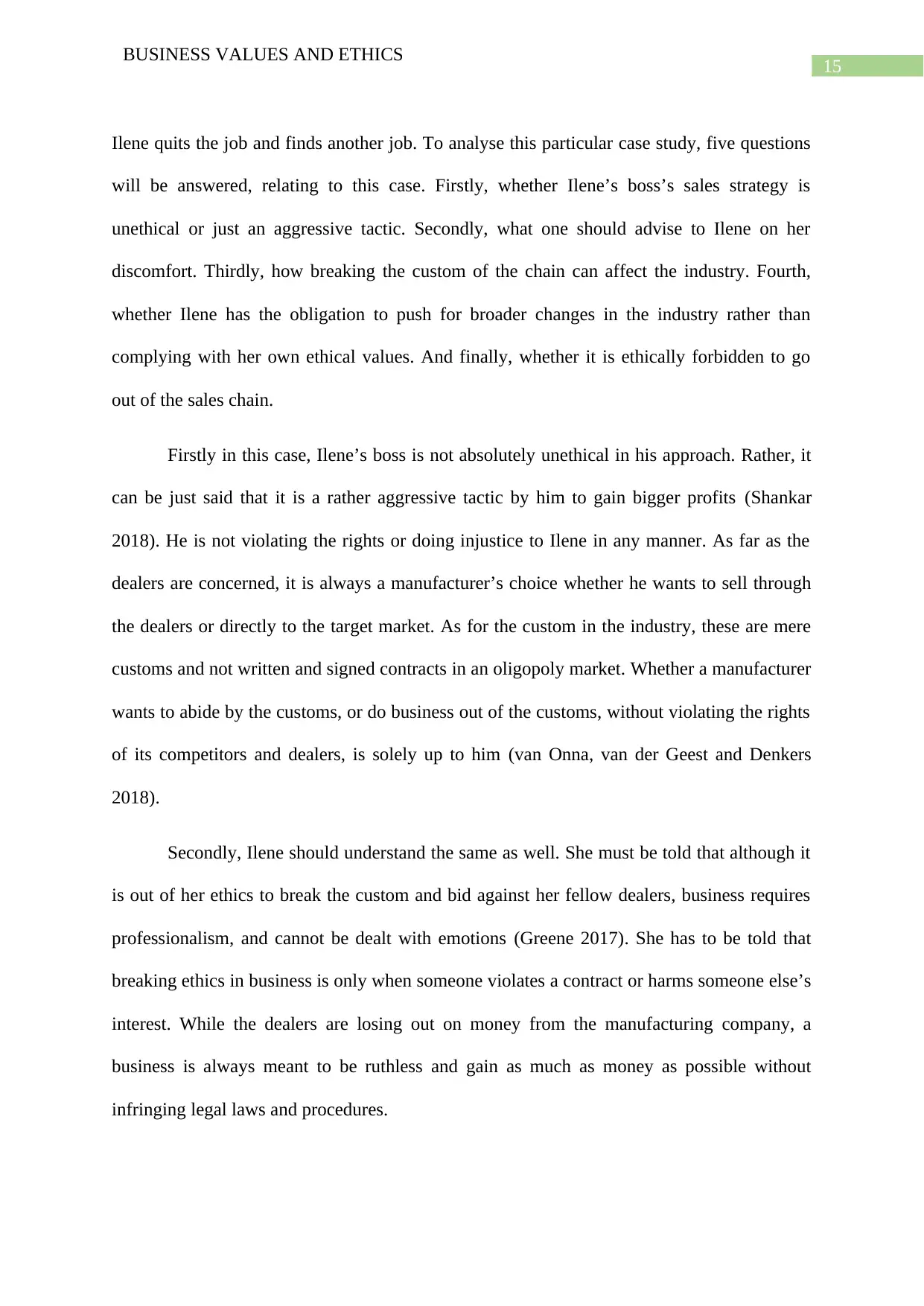
15
BUSINESS VALUES AND ETHICS
Ilene quits the job and finds another job. To analyse this particular case study, five questions
will be answered, relating to this case. Firstly, whether Ilene’s boss’s sales strategy is
unethical or just an aggressive tactic. Secondly, what one should advise to Ilene on her
discomfort. Thirdly, how breaking the custom of the chain can affect the industry. Fourth,
whether Ilene has the obligation to push for broader changes in the industry rather than
complying with her own ethical values. And finally, whether it is ethically forbidden to go
out of the sales chain.
Firstly in this case, Ilene’s boss is not absolutely unethical in his approach. Rather, it
can be just said that it is a rather aggressive tactic by him to gain bigger profits (Shankar
2018). He is not violating the rights or doing injustice to Ilene in any manner. As far as the
dealers are concerned, it is always a manufacturer’s choice whether he wants to sell through
the dealers or directly to the target market. As for the custom in the industry, these are mere
customs and not written and signed contracts in an oligopoly market. Whether a manufacturer
wants to abide by the customs, or do business out of the customs, without violating the rights
of its competitors and dealers, is solely up to him (van Onna, van der Geest and Denkers
2018).
Secondly, Ilene should understand the same as well. She must be told that although it
is out of her ethics to break the custom and bid against her fellow dealers, business requires
professionalism, and cannot be dealt with emotions (Greene 2017). She has to be told that
breaking ethics in business is only when someone violates a contract or harms someone else’s
interest. While the dealers are losing out on money from the manufacturing company, a
business is always meant to be ruthless and gain as much as money as possible without
infringing legal laws and procedures.
BUSINESS VALUES AND ETHICS
Ilene quits the job and finds another job. To analyse this particular case study, five questions
will be answered, relating to this case. Firstly, whether Ilene’s boss’s sales strategy is
unethical or just an aggressive tactic. Secondly, what one should advise to Ilene on her
discomfort. Thirdly, how breaking the custom of the chain can affect the industry. Fourth,
whether Ilene has the obligation to push for broader changes in the industry rather than
complying with her own ethical values. And finally, whether it is ethically forbidden to go
out of the sales chain.
Firstly in this case, Ilene’s boss is not absolutely unethical in his approach. Rather, it
can be just said that it is a rather aggressive tactic by him to gain bigger profits (Shankar
2018). He is not violating the rights or doing injustice to Ilene in any manner. As far as the
dealers are concerned, it is always a manufacturer’s choice whether he wants to sell through
the dealers or directly to the target market. As for the custom in the industry, these are mere
customs and not written and signed contracts in an oligopoly market. Whether a manufacturer
wants to abide by the customs, or do business out of the customs, without violating the rights
of its competitors and dealers, is solely up to him (van Onna, van der Geest and Denkers
2018).
Secondly, Ilene should understand the same as well. She must be told that although it
is out of her ethics to break the custom and bid against her fellow dealers, business requires
professionalism, and cannot be dealt with emotions (Greene 2017). She has to be told that
breaking ethics in business is only when someone violates a contract or harms someone else’s
interest. While the dealers are losing out on money from the manufacturing company, a
business is always meant to be ruthless and gain as much as money as possible without
infringing legal laws and procedures.
Secure Best Marks with AI Grader
Need help grading? Try our AI Grader for instant feedback on your assignments.
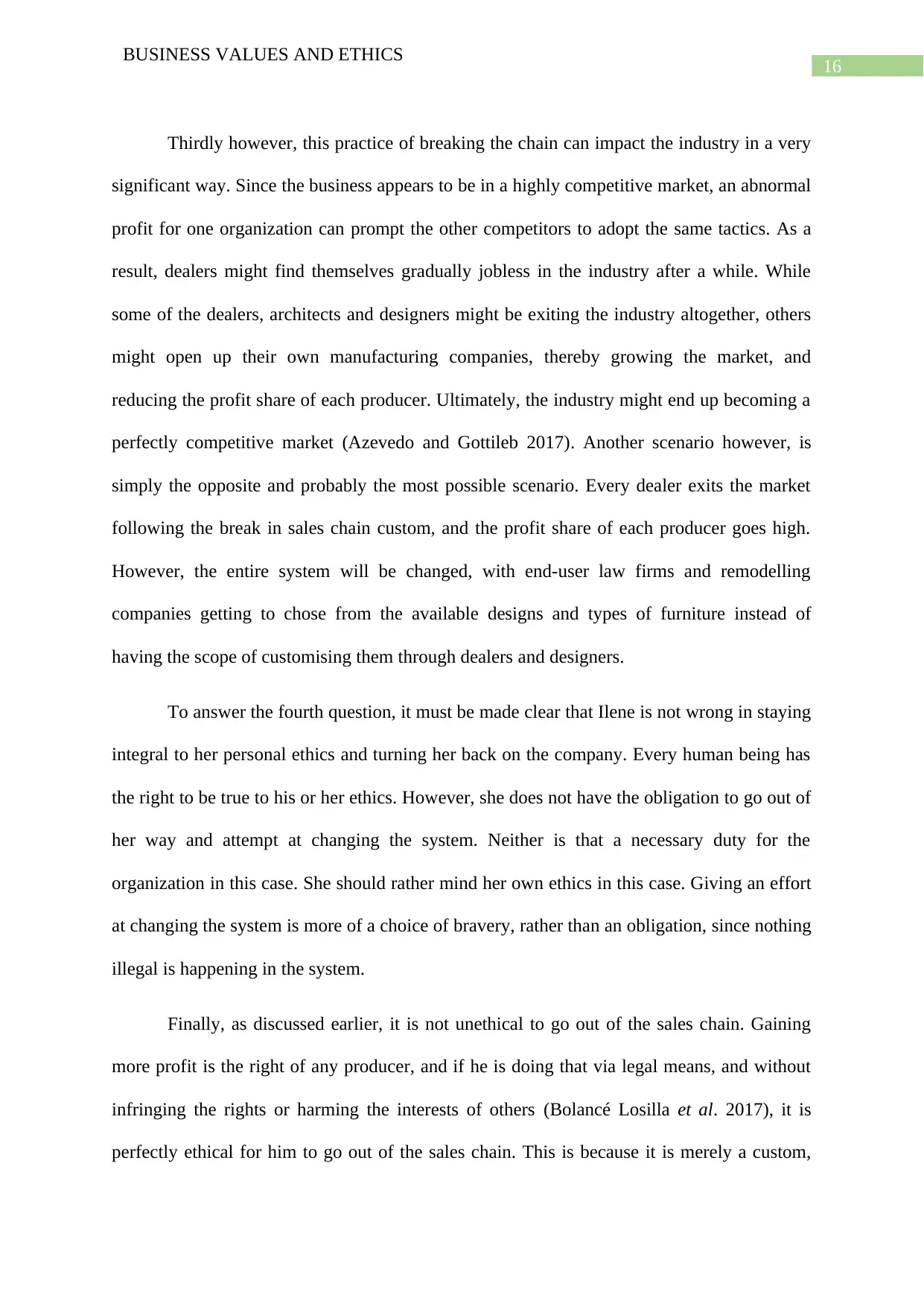
16
BUSINESS VALUES AND ETHICS
Thirdly however, this practice of breaking the chain can impact the industry in a very
significant way. Since the business appears to be in a highly competitive market, an abnormal
profit for one organization can prompt the other competitors to adopt the same tactics. As a
result, dealers might find themselves gradually jobless in the industry after a while. While
some of the dealers, architects and designers might be exiting the industry altogether, others
might open up their own manufacturing companies, thereby growing the market, and
reducing the profit share of each producer. Ultimately, the industry might end up becoming a
perfectly competitive market (Azevedo and Gottileb 2017). Another scenario however, is
simply the opposite and probably the most possible scenario. Every dealer exits the market
following the break in sales chain custom, and the profit share of each producer goes high.
However, the entire system will be changed, with end-user law firms and remodelling
companies getting to chose from the available designs and types of furniture instead of
having the scope of customising them through dealers and designers.
To answer the fourth question, it must be made clear that Ilene is not wrong in staying
integral to her personal ethics and turning her back on the company. Every human being has
the right to be true to his or her ethics. However, she does not have the obligation to go out of
her way and attempt at changing the system. Neither is that a necessary duty for the
organization in this case. She should rather mind her own ethics in this case. Giving an effort
at changing the system is more of a choice of bravery, rather than an obligation, since nothing
illegal is happening in the system.
Finally, as discussed earlier, it is not unethical to go out of the sales chain. Gaining
more profit is the right of any producer, and if he is doing that via legal means, and without
infringing the rights or harming the interests of others (Bolancé Losilla et al. 2017), it is
perfectly ethical for him to go out of the sales chain. This is because it is merely a custom,
BUSINESS VALUES AND ETHICS
Thirdly however, this practice of breaking the chain can impact the industry in a very
significant way. Since the business appears to be in a highly competitive market, an abnormal
profit for one organization can prompt the other competitors to adopt the same tactics. As a
result, dealers might find themselves gradually jobless in the industry after a while. While
some of the dealers, architects and designers might be exiting the industry altogether, others
might open up their own manufacturing companies, thereby growing the market, and
reducing the profit share of each producer. Ultimately, the industry might end up becoming a
perfectly competitive market (Azevedo and Gottileb 2017). Another scenario however, is
simply the opposite and probably the most possible scenario. Every dealer exits the market
following the break in sales chain custom, and the profit share of each producer goes high.
However, the entire system will be changed, with end-user law firms and remodelling
companies getting to chose from the available designs and types of furniture instead of
having the scope of customising them through dealers and designers.
To answer the fourth question, it must be made clear that Ilene is not wrong in staying
integral to her personal ethics and turning her back on the company. Every human being has
the right to be true to his or her ethics. However, she does not have the obligation to go out of
her way and attempt at changing the system. Neither is that a necessary duty for the
organization in this case. She should rather mind her own ethics in this case. Giving an effort
at changing the system is more of a choice of bravery, rather than an obligation, since nothing
illegal is happening in the system.
Finally, as discussed earlier, it is not unethical to go out of the sales chain. Gaining
more profit is the right of any producer, and if he is doing that via legal means, and without
infringing the rights or harming the interests of others (Bolancé Losilla et al. 2017), it is
perfectly ethical for him to go out of the sales chain. This is because it is merely a custom,
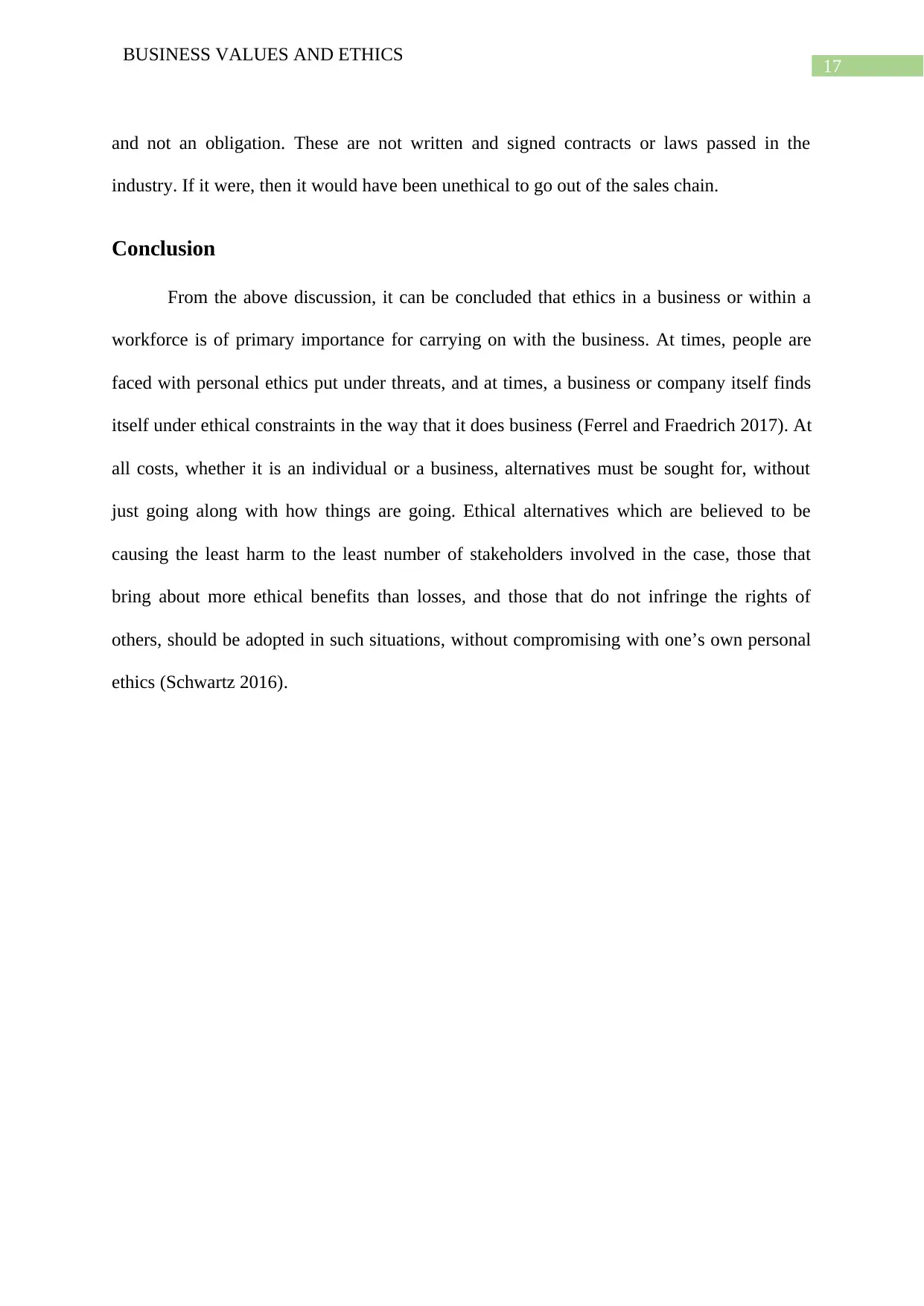
17
BUSINESS VALUES AND ETHICS
and not an obligation. These are not written and signed contracts or laws passed in the
industry. If it were, then it would have been unethical to go out of the sales chain.
Conclusion
From the above discussion, it can be concluded that ethics in a business or within a
workforce is of primary importance for carrying on with the business. At times, people are
faced with personal ethics put under threats, and at times, a business or company itself finds
itself under ethical constraints in the way that it does business (Ferrel and Fraedrich 2017). At
all costs, whether it is an individual or a business, alternatives must be sought for, without
just going along with how things are going. Ethical alternatives which are believed to be
causing the least harm to the least number of stakeholders involved in the case, those that
bring about more ethical benefits than losses, and those that do not infringe the rights of
others, should be adopted in such situations, without compromising with one’s own personal
ethics (Schwartz 2016).
BUSINESS VALUES AND ETHICS
and not an obligation. These are not written and signed contracts or laws passed in the
industry. If it were, then it would have been unethical to go out of the sales chain.
Conclusion
From the above discussion, it can be concluded that ethics in a business or within a
workforce is of primary importance for carrying on with the business. At times, people are
faced with personal ethics put under threats, and at times, a business or company itself finds
itself under ethical constraints in the way that it does business (Ferrel and Fraedrich 2017). At
all costs, whether it is an individual or a business, alternatives must be sought for, without
just going along with how things are going. Ethical alternatives which are believed to be
causing the least harm to the least number of stakeholders involved in the case, those that
bring about more ethical benefits than losses, and those that do not infringe the rights of
others, should be adopted in such situations, without compromising with one’s own personal
ethics (Schwartz 2016).
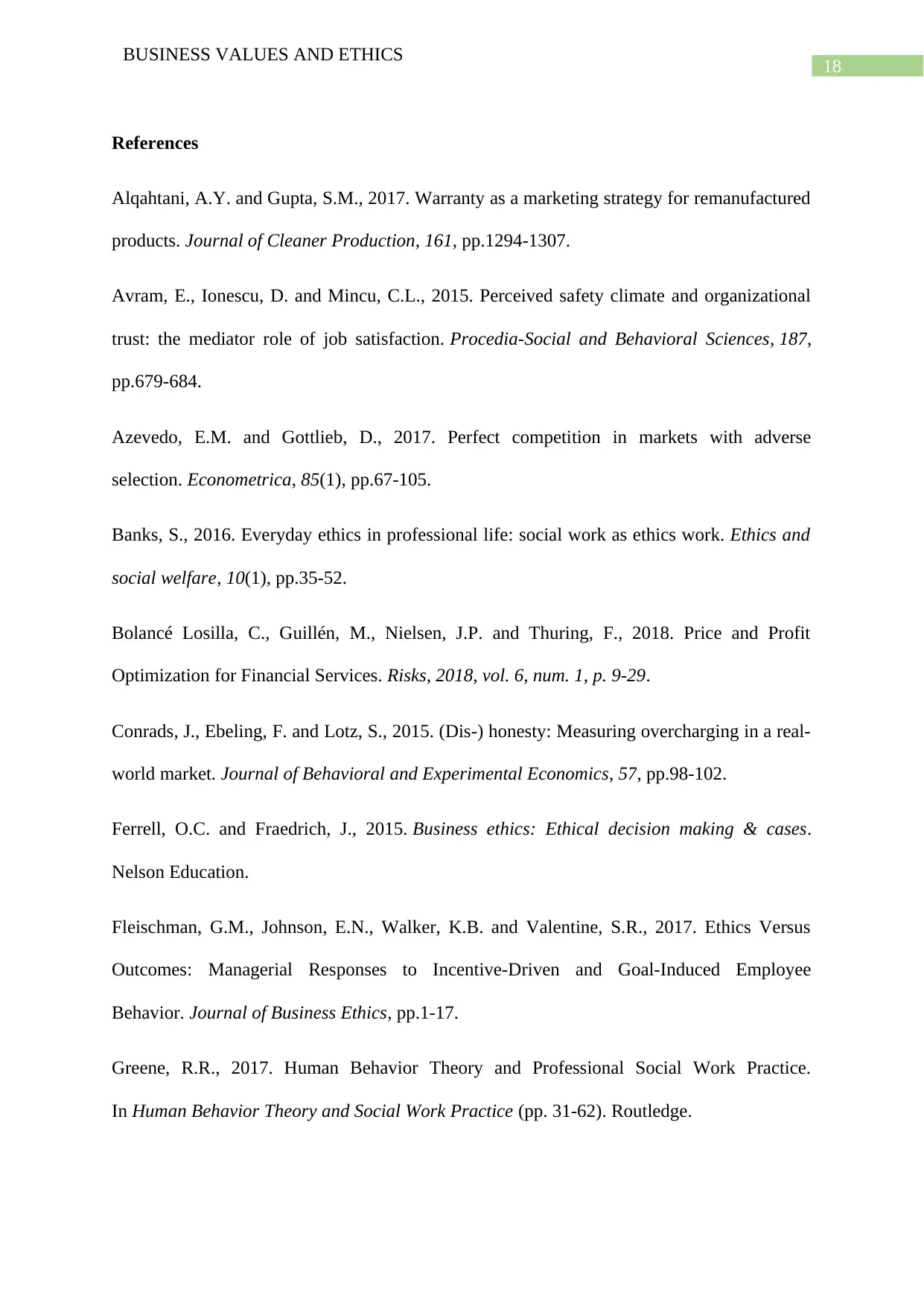
18
BUSINESS VALUES AND ETHICS
References
Alqahtani, A.Y. and Gupta, S.M., 2017. Warranty as a marketing strategy for remanufactured
products. Journal of Cleaner Production, 161, pp.1294-1307.
Avram, E., Ionescu, D. and Mincu, C.L., 2015. Perceived safety climate and organizational
trust: the mediator role of job satisfaction. Procedia-Social and Behavioral Sciences, 187,
pp.679-684.
Azevedo, E.M. and Gottlieb, D., 2017. Perfect competition in markets with adverse
selection. Econometrica, 85(1), pp.67-105.
Banks, S., 2016. Everyday ethics in professional life: social work as ethics work. Ethics and
social welfare, 10(1), pp.35-52.
Bolancé Losilla, C., Guillén, M., Nielsen, J.P. and Thuring, F., 2018. Price and Profit
Optimization for Financial Services. Risks, 2018, vol. 6, num. 1, p. 9-29.
Conrads, J., Ebeling, F. and Lotz, S., 2015. (Dis-) honesty: Measuring overcharging in a real-
world market. Journal of Behavioral and Experimental Economics, 57, pp.98-102.
Ferrell, O.C. and Fraedrich, J., 2015. Business ethics: Ethical decision making & cases.
Nelson Education.
Fleischman, G.M., Johnson, E.N., Walker, K.B. and Valentine, S.R., 2017. Ethics Versus
Outcomes: Managerial Responses to Incentive-Driven and Goal-Induced Employee
Behavior. Journal of Business Ethics, pp.1-17.
Greene, R.R., 2017. Human Behavior Theory and Professional Social Work Practice.
In Human Behavior Theory and Social Work Practice (pp. 31-62). Routledge.
BUSINESS VALUES AND ETHICS
References
Alqahtani, A.Y. and Gupta, S.M., 2017. Warranty as a marketing strategy for remanufactured
products. Journal of Cleaner Production, 161, pp.1294-1307.
Avram, E., Ionescu, D. and Mincu, C.L., 2015. Perceived safety climate and organizational
trust: the mediator role of job satisfaction. Procedia-Social and Behavioral Sciences, 187,
pp.679-684.
Azevedo, E.M. and Gottlieb, D., 2017. Perfect competition in markets with adverse
selection. Econometrica, 85(1), pp.67-105.
Banks, S., 2016. Everyday ethics in professional life: social work as ethics work. Ethics and
social welfare, 10(1), pp.35-52.
Bolancé Losilla, C., Guillén, M., Nielsen, J.P. and Thuring, F., 2018. Price and Profit
Optimization for Financial Services. Risks, 2018, vol. 6, num. 1, p. 9-29.
Conrads, J., Ebeling, F. and Lotz, S., 2015. (Dis-) honesty: Measuring overcharging in a real-
world market. Journal of Behavioral and Experimental Economics, 57, pp.98-102.
Ferrell, O.C. and Fraedrich, J., 2015. Business ethics: Ethical decision making & cases.
Nelson Education.
Fleischman, G.M., Johnson, E.N., Walker, K.B. and Valentine, S.R., 2017. Ethics Versus
Outcomes: Managerial Responses to Incentive-Driven and Goal-Induced Employee
Behavior. Journal of Business Ethics, pp.1-17.
Greene, R.R., 2017. Human Behavior Theory and Professional Social Work Practice.
In Human Behavior Theory and Social Work Practice (pp. 31-62). Routledge.
Paraphrase This Document
Need a fresh take? Get an instant paraphrase of this document with our AI Paraphraser
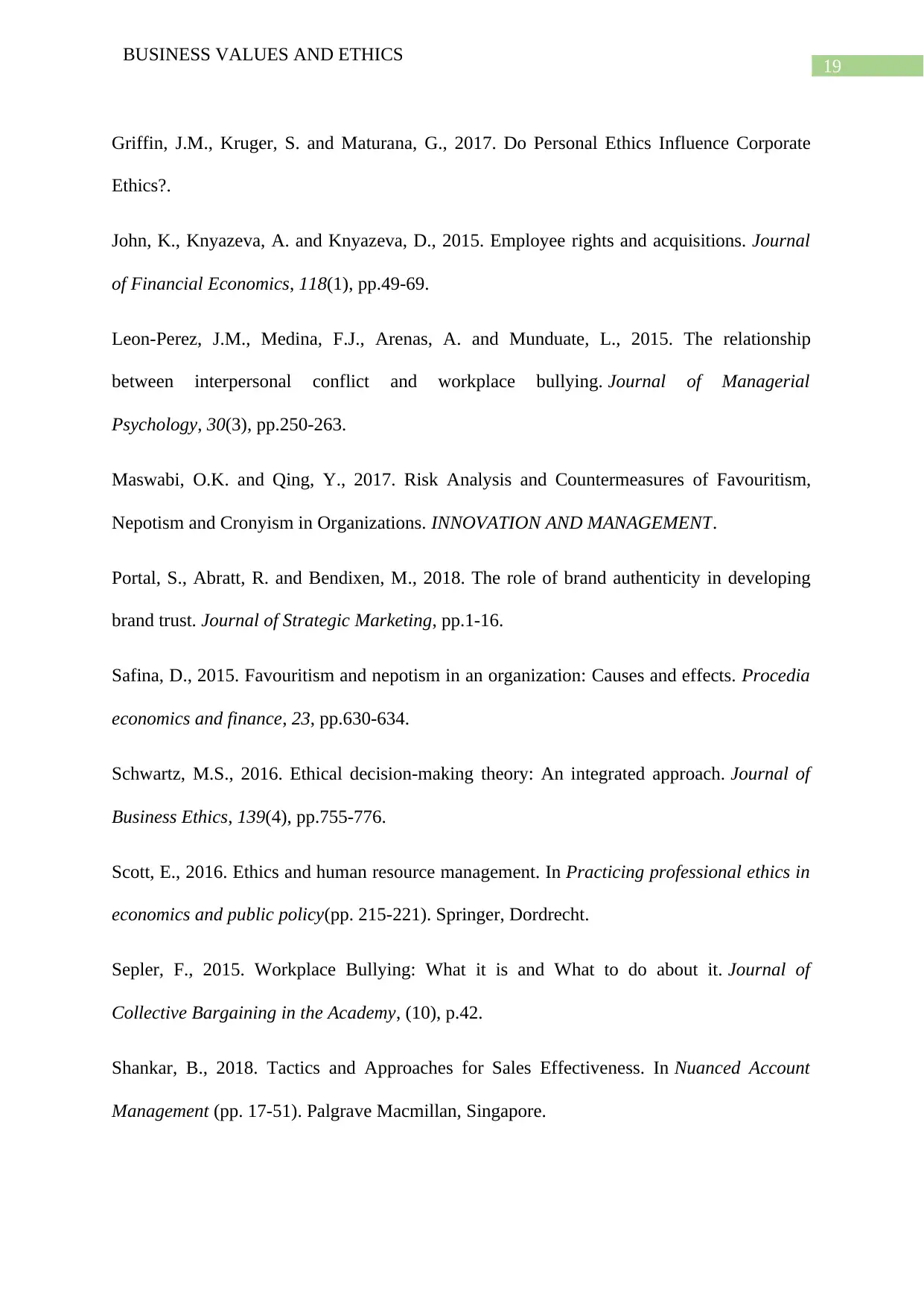
19
BUSINESS VALUES AND ETHICS
Griffin, J.M., Kruger, S. and Maturana, G., 2017. Do Personal Ethics Influence Corporate
Ethics?.
John, K., Knyazeva, A. and Knyazeva, D., 2015. Employee rights and acquisitions. Journal
of Financial Economics, 118(1), pp.49-69.
Leon-Perez, J.M., Medina, F.J., Arenas, A. and Munduate, L., 2015. The relationship
between interpersonal conflict and workplace bullying. Journal of Managerial
Psychology, 30(3), pp.250-263.
Maswabi, O.K. and Qing, Y., 2017. Risk Analysis and Countermeasures of Favouritism,
Nepotism and Cronyism in Organizations. INNOVATION AND MANAGEMENT.
Portal, S., Abratt, R. and Bendixen, M., 2018. The role of brand authenticity in developing
brand trust. Journal of Strategic Marketing, pp.1-16.
Safina, D., 2015. Favouritism and nepotism in an organization: Causes and effects. Procedia
economics and finance, 23, pp.630-634.
Schwartz, M.S., 2016. Ethical decision-making theory: An integrated approach. Journal of
Business Ethics, 139(4), pp.755-776.
Scott, E., 2016. Ethics and human resource management. In Practicing professional ethics in
economics and public policy(pp. 215-221). Springer, Dordrecht.
Sepler, F., 2015. Workplace Bullying: What it is and What to do about it. Journal of
Collective Bargaining in the Academy, (10), p.42.
Shankar, B., 2018. Tactics and Approaches for Sales Effectiveness. In Nuanced Account
Management (pp. 17-51). Palgrave Macmillan, Singapore.
BUSINESS VALUES AND ETHICS
Griffin, J.M., Kruger, S. and Maturana, G., 2017. Do Personal Ethics Influence Corporate
Ethics?.
John, K., Knyazeva, A. and Knyazeva, D., 2015. Employee rights and acquisitions. Journal
of Financial Economics, 118(1), pp.49-69.
Leon-Perez, J.M., Medina, F.J., Arenas, A. and Munduate, L., 2015. The relationship
between interpersonal conflict and workplace bullying. Journal of Managerial
Psychology, 30(3), pp.250-263.
Maswabi, O.K. and Qing, Y., 2017. Risk Analysis and Countermeasures of Favouritism,
Nepotism and Cronyism in Organizations. INNOVATION AND MANAGEMENT.
Portal, S., Abratt, R. and Bendixen, M., 2018. The role of brand authenticity in developing
brand trust. Journal of Strategic Marketing, pp.1-16.
Safina, D., 2015. Favouritism and nepotism in an organization: Causes and effects. Procedia
economics and finance, 23, pp.630-634.
Schwartz, M.S., 2016. Ethical decision-making theory: An integrated approach. Journal of
Business Ethics, 139(4), pp.755-776.
Scott, E., 2016. Ethics and human resource management. In Practicing professional ethics in
economics and public policy(pp. 215-221). Springer, Dordrecht.
Sepler, F., 2015. Workplace Bullying: What it is and What to do about it. Journal of
Collective Bargaining in the Academy, (10), p.42.
Shankar, B., 2018. Tactics and Approaches for Sales Effectiveness. In Nuanced Account
Management (pp. 17-51). Palgrave Macmillan, Singapore.
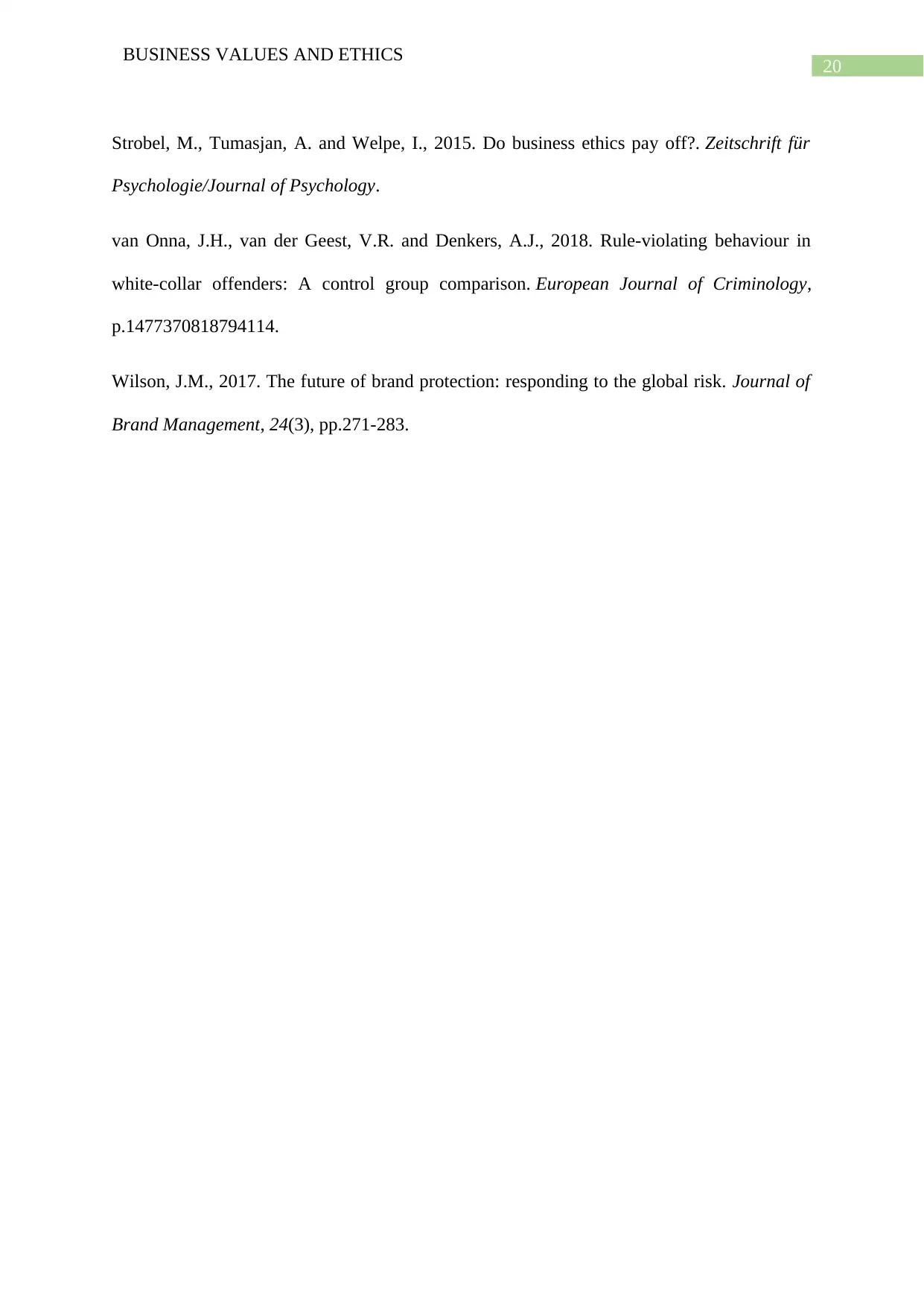
20
BUSINESS VALUES AND ETHICS
Strobel, M., Tumasjan, A. and Welpe, I., 2015. Do business ethics pay off?. Zeitschrift für
Psychologie/Journal of Psychology.
van Onna, J.H., van der Geest, V.R. and Denkers, A.J., 2018. Rule-violating behaviour in
white-collar offenders: A control group comparison. European Journal of Criminology,
p.1477370818794114.
Wilson, J.M., 2017. The future of brand protection: responding to the global risk. Journal of
Brand Management, 24(3), pp.271-283.
BUSINESS VALUES AND ETHICS
Strobel, M., Tumasjan, A. and Welpe, I., 2015. Do business ethics pay off?. Zeitschrift für
Psychologie/Journal of Psychology.
van Onna, J.H., van der Geest, V.R. and Denkers, A.J., 2018. Rule-violating behaviour in
white-collar offenders: A control group comparison. European Journal of Criminology,
p.1477370818794114.
Wilson, J.M., 2017. The future of brand protection: responding to the global risk. Journal of
Brand Management, 24(3), pp.271-283.
1 out of 21
Related Documents
Your All-in-One AI-Powered Toolkit for Academic Success.
+13062052269
info@desklib.com
Available 24*7 on WhatsApp / Email
![[object Object]](/_next/static/media/star-bottom.7253800d.svg)
Unlock your academic potential
© 2024 | Zucol Services PVT LTD | All rights reserved.




